- Spains 7 Must Visit Moorish...

Spain’s 7 Must-Visit Moorish Sites

The Moors arrived in Spain from North Africa and ruled parts of the Iberian Peninsula from 711 AD until the fall of Granada in 1492. Over 700 years of Islamic rule has left a rich legacy of architecture and culture in several Spanish cities. We take a look at seven of Spain’s must-visit Moorish sites.
The alhambra, granada.
Spain’s best-known Moorish site is the vast hilltop fortress of the Alhambra , whose picturesque setting with a background of the snowy peaks of the Sierra Nevada, looks like it came straight out of a fairy tale. The Alhambra, meaning ‘red castle’ in Arabic, was built as a small fortress in 889 AD and rebuilt as a grand palace in the mid-13th century by Mohammed ben Al-Ahmar, aka Mohammed I of Granada . With the conquest of Granada in 1492, it was converted into the Royal Court of the Catholic Monarchs, Ferdinand and Isabella. Its architecture and interiors are one of the best examples of Islamic design in Western Europe – the walls are covered in script, carvings and mosaics.

The Great Mosque of Córdoba
The Great Mosque of Córdoba was built in 784 by Abd al-Rahman I, its design inspired by the mosques of Damascus and al-Aqsa in Jerusalem. Its original design, with Roman-inspired red and white columns and arches that split the vast space into 11 naves, would become influential in the world of architecture. The mosque, which was later expanded, was the centre of Islamic life in Córdoba for over three centuries and was renowned for its great beauty throughout Al-Andalus. It was converted into a Catholic church in 1236 when Christians took over the rule of the city. These days, it is the Mosque-Cathedral of Córdoba and used as a Christian place of worship.

Royal Alcázar of Seville
More a homage to Moorish architecture than a Moorish site itself, the Royal Alcázar of Seville was built for King Peter of Castile and some of the same artisans who worked on the Alhambra over the years helped fashion its ornate interiors. It is still used by the Spanish royal family as their official residence in Seville, making it the oldest royal palace still in use in Europe.

Medina Azahara, Córdoba
Spain’s newest UNESCO World Heritage Site was built as an huge palace-city complex on the slopes overlooking Córdoba between 936 and 940 AD. It was a bustling metropolis and the centre of the Caliphate of Córdoba, home to the government, mosques, the mint, residential and administrative buildings and workshops. By 1010 AD it had been destroyed during a civil war, and it subsequently lay buried for centuries before being unearthed in the early 1900s. Today, although barely 10 percent of the complex has been excavated, it gives us a glimpse of the power of Spain’s early Muslim rulers.

Aljafería, Zaragoza
This Islamic palace was built in the 11th century in the Taifa of Zaragoza, one of the most northerly outposts of Al-Andalus, located in the north-eastern city of Zaragoza. It was later residence of the Christian kings of Aragon and today is used as the headquarters of the regional parliament of Aragon.

Giralda, Seville
The Giralda is one of the of the only remnants of the Great Mosque of Seville that once stood on the site of Seville’s cathedral , which is today the largest Gothic cathedral in the world. The former minaret is now the cathedral’s bell tower and visitors can climb to the top by walking up a series of ramps. The ramps were installed instead of stairs, so legend has it, so that even animals were able to walk up to the top.

Become a Culture Tripper!
Sign up to our newsletter to save up to $1,395 on our unique trips..
See privacy policy .

Mesquita del Cristo de la Luz, Toledo
The city of Toledo , southwest of Madrid, experienced a long period of ‘ convivencia ‘ during the Middle Ages, when Christians, Jews and Muslims lived in harmony. The flourishing of all three cultures bestowed the city with a feast of architecture, including the Mosque of Cristo de la Luz. The small mosque was built in 999 and was one of ten in the city. The brickwork on the exterior of the building was designed to resemble Córdoba’s Great Mosque.

Guides & Tips
The best private trips to book for a foodie adventure.

See & Do
Getting a taste of picasso in malaga.

The Best Places to Travel in June

Top Tips for Travelling in Spain

Places to Stay
The best hotels to book in salou, catalonia.

The Best Hotels to Book in Catalonia

Reasons Why You Should Visit Andalucia, Spain

Reasons Why You Should Visit La Rioja, Spain

Bars & Cafes
The best wine bars in la rioja, spain.

The Most Beautiful Train Stations in the World

The Most Unique Temples and Churches in the World

The Best Private Trips to Book for Your Spanish Class
Culture Trip Summer Sale
Save up to $1,395 on our unique small-group trips! Limited spots.

- Post ID: 1000234955
- Sponsored? No
- View Payload
The best places to experience Moorish Spain
Book your individual trip , stress-free with local travel experts
Select Month
- roughguides.com
- moorish-spain
Plan your tailor-made trip with a local expert
Book securely with money-back guarantee
Travel stress-free with local assistance and 24/7 support

written by Esme Fox
updated 05.06.2024
escended from North African tribes of Berbers and Arabs, the Moors ruled parts of Spain from the eighth until the fifteenth century, focusing much of their domination on the southern province of Andalucía . During their 800-year rule, the Moors inevitably left their mark upon Spanish culture – in its cuisine, language and architecture. Many vestiges of Spain’s Moorish past can still be seen today, from magnificent palaces, to towering fortresses and mesmerising mosques. Here, Esme Fox tells us where to see the best of Moorish Spain.
The Alhambra, Granada
Albaicín, granada, la giralda, seville, the alcázar, seville, la mezquita, córdoba, the aljaferiá, zaragoza, the alcazaba, málaga, travel ideas for spain, created by local experts.

Andalucía Explored
Discover the best of Andalucía's breathtaking palaces, churches, museums, vineyards, and more, as you travel through spectacular scenery dotted with pueblos blancos and bordered by rugged mountains and coast en route to Granada, Seville, Ronda and Jerez de la Frontera.

A culinary experience in Seville
Explore the cuisine and surroundings of Seville in Andalucia. From Iberian ham over sherry wines to the production and secrets of olive oil, this tour is an ideal weekend getaway. Decide yourself if you prefer a rental car or a chauffeur-driven car to explore the beauty of Andalucia.

Spanish Honeymoon
Discover Andalusia, starting with the cultural city of Seville, then on to Córdoba and Granada, home of the stunning Alhambra Palace. Next you'll visit Granada and the Albayzin Arab quarter, then enjoy a stunning hot-air balloon ride, before ending your trip with a luxury boat trip from Marbella!
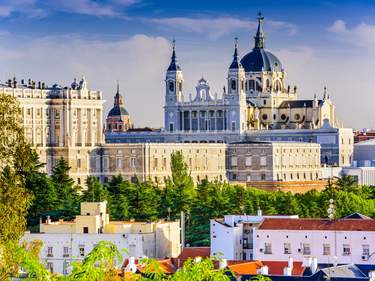
Made for Madrid
Take to the Spanish capital for art, culture and a taste of life in the city, Madrileño-style. Explore age-old churches and pretty plazas, stroll through the lovely Buen Retiro Park and visit captivating Toledo. Then, come sundown, discover the city's vibrant barrios and lively nightlife.
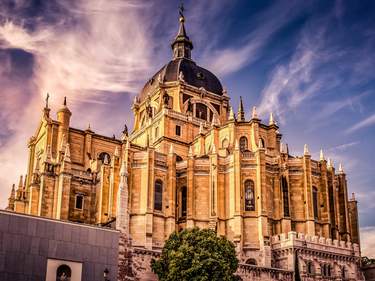
A Madrid getaway
Spend four days discovering the wonders of Spain's capital Madrid: from fascinating museums like El Prado and Reina Sofia over exploring unknown corners with your private guide to a day trip to the surroundings, this itinerary packs the best of Madrid.

Hidden Spain - From Barcelona to Basque Country
Do you want to explore highlights in Spain while staying in nature at the same time? Look no further. Start your Spanish adventure in Barcelona before heading off to the mountains - drive your rental car to Andorra and further on to Basque Country. Decide between driving yourself or guided tours.
If you only have time to visit just one of Spain’s Moorish sites, then it’s got to be Granada ’s impressive Alhambra . Presiding over the city like an ornate crown, the fortress was the Moors last stronghold in Spain. Parts of the complex date as far back as the ninth century, although most of what survives today was built in the fourteenth century by the rulers Yusuf I and Mohammed V.
The author Washington Irving, who actually lived in the Alhambra for a while, wrote of the palace: "Everything here appears calculated to inspire kind and happy feelings, for everything is delicate and beautiful." His words seem apt when standing in rooms of such lavish beauty, fountain-filled courtyards and the fragrant gardens of the Generalife. Tickets allow for half a day’s exploration of the complex, but even this is nowhere near enough time to properly take in everything. You’ll just have to promise yourself that you will return.
If you're planning a trip to Spain, don't miss our Spain itineraries and information on how to get there .

Alhambra in Granada © Shutterstock
Don’t leave Granada without visiting the Moorish district of Albaicín, with its steep cobbled streets, Arabic style arches, ornate tiles and doorways. Today, the lower streets still feel like they’re inhabited by the Moors, lined by Moroccan souvenir shops overflowing with sparkling, multicoloured lamps and carved leather handbags.
Stop for a drink at one of the intricately decorated teterías (teahouses), where the smells of spiced-infused concoctions drift through the air. If you want to immerse yourself in Moorish Spain, take a look at 9 special places to stay in Andalucía .
Built on the site of the old mosque, La Giralda is a Gothic- and Renaissance-style cathedral incorporates the original Islamic minaret as its bell tower. La Giralda dates back to the end of the twelfth century and is one of only three remaining Almohad minarets left in the world. Walk up the unique series of slopes to reach the top of the tower and marvel at the spectacular views over the rooftops of Seville .
Although the Alcázar is not as large as the Alhambra, parts of its interiors are just as impressive. Surrounded by lush palm gardens and high walls, it was built primarily during the 1300s as a fort for the governors of Seville. During the subsequent 1100 years, the Alcázar has been reconstructed many times, both by the Almohad rulers and by the Catholic monarchs after they recaptured Seville in 1248.
The fortress’s showpiece is without doubt the extravagant Mudéjar Palacio de Don Pedro, built by Pedro I between 1364 and 1366 and made by some of the same artisans who created parts of the Alhambra. Make your way through sumptuous rooms of elaborate portico arches, star-scattered domes, glittering gold plaster work and tranquil sunken gardens. One can certainly see why the producers of Game of Thrones chose this as a setting for season five.

Alcazar, Seville © Shutterstock
Part mosque and part cathedral, Córdoba ’s La Mezquita is quite a sight to behold with its detailed Arabic arches, heavy gold doors and thick stonewalls. Enter through an orange tree-filled patio into the vast interior, packed with exotic red and white arches, delicate Byzantine mosaics in flashes of gold and over 850 marble pillars. The Arabic parts date back to the tenth century, while the central Renaissance-style cathedral is around 500 years old. When the Spanish recaptured Córdoba in 1236, the mosque was consecrated as a cathedral, however more Arabic Mudéjar elements, as well as Gothic-style structures were added at later dates.

La Mezquita, Cordoba © Shutterstock
Although most of Spain’s best Moorish sights can be found in Andalucía, there are still some surviving in other parts of Spain, the best-preserved being The Aljaferiá in the north-eastern city of Zaragoza . Built as a pleasure palace in the eleventh century, it later fell in into the hands of the Catholic monarchs Fernando II and Isabella I, who put their own stamp on the building. Today, it serves as the headquarters of Aragón’s regional parliament, with visitor tours taking place throughout the day. Of notable interest is the elaborate octagonal prayer room and mihrab (a semi-circular niche in the wall that denotes the direction of Mecca), decorated in floral patterns and inscriptions from the Qur’an.
The palatial fortress of Málaga ’s Alcazaba sits on a green, verdant hill and towers over one of the city’s main plazas. Fronted by a large Roman amphitheatre, it’s a unique structure combining Roman, Arabic and Renaissance styles. According to historians, it was built at the instruction of Badis, King of the Berber Taifa of Granada between 1057 and 1063. Later, when Málaga became part of the Nasrid Kingdom, the Alcazaba was remodelled and its palatial elements were added.
It may not have all the intricate Mudéjar detail of the Alhambra or Seville’s Real Alcazár, but the building still makes for a fascinating exploration, meandering through the maze-like corridors, patios and gardens. The fortress is connected via a steep walled passageway to the Castillo de Gibralfaro, high above. The castle was built in the fourteenth century to protect the Alcazaba, and from up here you can enjoy one of the best views over Málaga city and its port.
Our guide to the best things to do in Málaga might help you to find more ideas for your holiday here.
Explore more of Spain with the Rough Guide to Spain . Compare flights , book hostels for your trip, and don’t forget to purchase travel insurance before you go.
- Inspiration
Planning your own trip? Prepare for your trip
Use Rough Guides' trusted partners for great rates
Travel advice for Spain
From travel safety to visa requirements, discover the best tips for traveling to Spain
- Culture and Etiquette in Spain
- Eating and drinking in Spain
- Getting around Spain: Transportation Tips
- How to get to Spain
- Sports and Outdoor activities in Spain
- Travel Tips Spain for planning and on the go
- Best time to visit Spain
Find even more inspiration for 1 here

Ready to travel and discover Spain?
Get support from our local experts for stress-free planning & worry-free travels.
- Where to stay
- Itineraries
- Travel advice
Editor's Choice
- Latest Articles
- How to Move Out of the U.S.
- Daily e-Letter
- All Destinations
- Best Places to Retire
- Our Experts
- Testimonials
- Real Estate
Moors in Spain: Explore the Best of Moorish Towns in Spain - IL
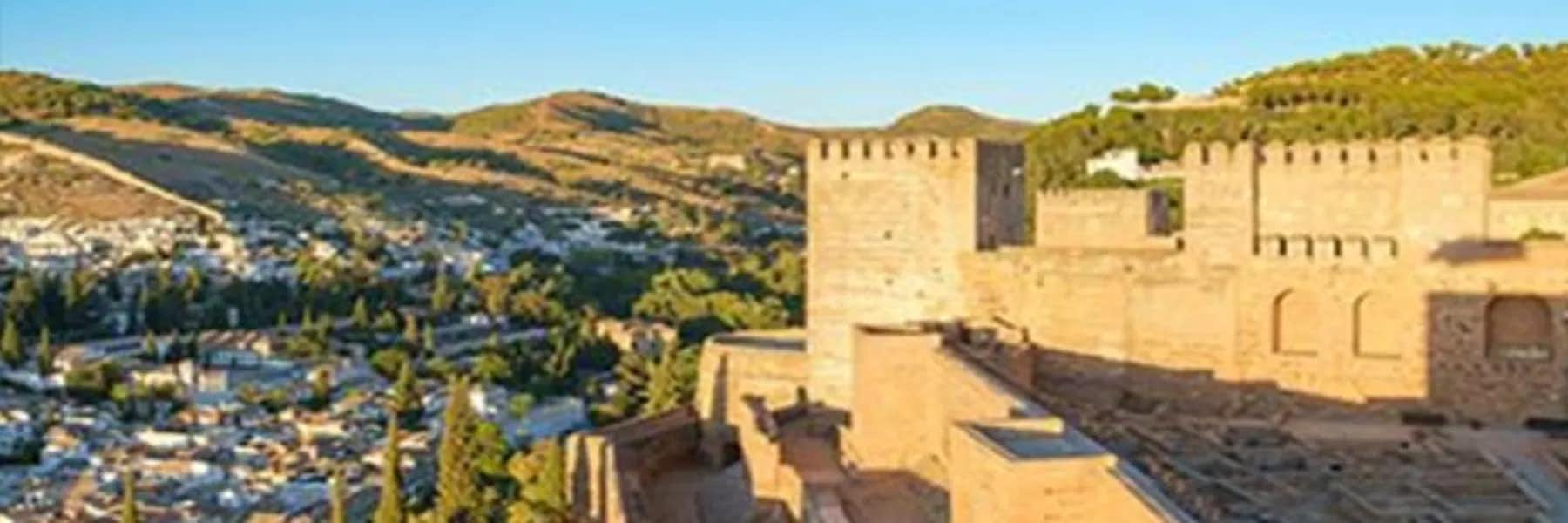
What’s a great way to plan your travel itinerary through Spain? In my experience, you can’t go wrong by focusing your attention on the cities and regions that boast the most jaw-dropping Moorish attractions.
The Moors have left an indelible mark on modern Spain , with many of their most impressive mosques, fortresses, and palaces still around today. Spain’s food , architecture and language have been wonderfully enriched by Moorish culture.
The Moors made their way to Spain from North Africa in 711 AD, ruling different parts of the country for more than seven centuries. Today, you can still find hidden parts of Spain that’ll make you feel you’ve stumbled into a Moroccan marketplace, complete with artisan crafts, colorful fabrics, and tiny cafes where you can enjoy spicy clay-pot cooking and sip sweet, minty tea from a glass.
Tidy rows of orange trees, narrow, twisting alleyways that maximize shade, heat-reflecting whitewashed buildings and cool, inviting courtyards are all part of the Moorish look that permeates so many parts of this nation, especially in the southern Andalusia region. Granada , Cordoba , and Seville are renowned Moorish hotspots, but lots of other Spanish cities have their share of must-see Moorish sites too.
By planning your next Spanish travel adventure around epic Moorish attractions, you’ll end up visiting some of the most breathtaking parts of the country—and gain a greater appreciation of a unique and vibrant culture in the process. So to help you get started, here are some of my all-time favorite Moorish sites in sunny Spain:
Alcazar of Seville

The ornate interiors, tile decorations, and spectacular facades of this royal palace incorporate a range of architectural styles, from Gothic and Romanesque to Renaissance and Baroque, with Islamic designs and patterns widely used during its numerous renovations.
The Spanish royal family still occupies the palace’s upper levels whenever they visit Seville. The grand buildings, fragrant gardens, courtyards, and reflection pools are so picturesque that they served as a film set for Lawrence of Arabia in 1962, and more recently featured in the fifth season of Game of Thrones.
Even the names of palace features are enchanting: Poet’s Garden, Grotesque Gallery, Admiral’s Room, and Maiden’s Courtyard. Give yourself two to three hours to explore the entire Alcazar thoroughly. Entry cost is about $13, with children free.
Another classic Seville attraction is the Giralda, in the city center. Originally built as a minaret for the city’s Great Mosque, it’s now a UNESCO-registered, 342-foot-tall cathedral bell tower. The walk to the top is along a series of ramps instead of stairs. Seville’s cathedral is the largest Gothic cathedral on earth.
The Alhambra (Granada)
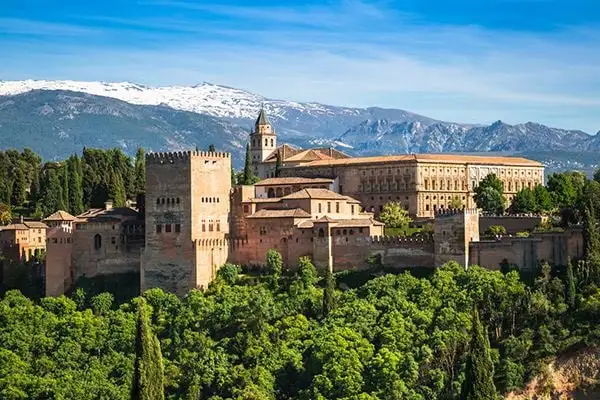
Of all Spain’s fairy-tale-like Moorish sites, none has a setting more spectacular than the Alhambra fortress, backed by the snowy peaks of the Sierra Nevada. It started out as a walled citadel in 889 AD and was later transformed into a grand Islamic palace and then the royal court of King Ferdinand and Queen Isabella. It’s considered by many to be the highest achievement of Moorish art in the country, with mosaics, carvings, and ancient script adorning the walls and courtyards.
The Alhambra’s centerpiece is the Palacios Nazaries complex, a collection of palaces, patios, corridors, high walls, towers, and elegant rectangular pools decorated with carved wood, stucco and intricate tiling. The visual grandeur is no less eye-popping at The Generalife, a 14-century sultan’s estate filled with shaded pathways, tinkling fountains, ancient trees, and flower-filled patios.
You can walk to the fortress from the center of Granada in about 15 minutes—the last section is the steepest. Alternatively, take the C3 bus that leaves every 10 minutes from Plaza Nueva and get off at the ‘Generalife’ station. Cost for a day visit, which includes the Gardens, Alcazaba, and Generalife, costs around $8.40 and is well worth it.
Mosque of Cristo de la Luz (Toledo)
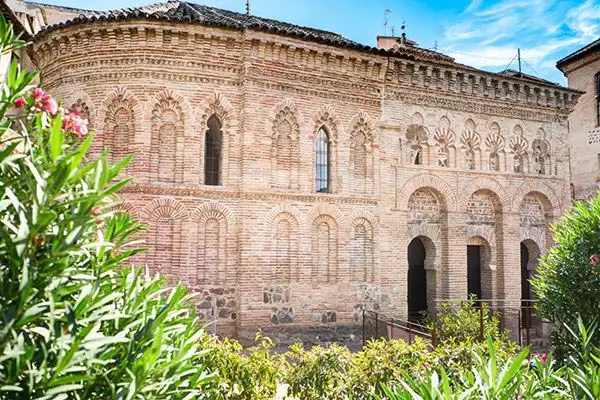
The ancient city of Toledo in central Spain is a 35 minute, $12 train trip from Madrid , and is well known for its fusion of Christian, Jewish, and Arab architecture. This small, beautiful mosque is one of the few in the country that’s still in virtually the same condition as when it was first built (in the year 999). Around 1085, it was converted into a Christian church.
Made of small stones and brick, its façade has been constructed to resemble the Mosque-Cathedral in Cordoba. Inside, horseshoe-shaped arches are supported by decoratively carved columns; the highest arch is 30 feet above the floor. Entry fee is $2 to $3.
The Mosque-Cathedral of Cordoba
For more than three centuries, the Great Mosque of Cordoba was this city’s hub of Islamic life and was renowned throughout Spain for its size and beauty. Its red and white arches, symmetrical rows of Roman columns and stylish use of ornamental gold, silver, ivory, brass, and copper make it one of the most influential Moorish architectural achievements.
Built in 784, it became a Catholic church in 1286. It features 856 columns made of marble, onyx, jasper, porphyry, and granite. An entrance patio lined with orange trees leads to an expansive interior protected by sturdy stone walls and weighty gold doors. The interior mosaics are carefully crafted and the entire structure feels grandly serene.
Entry is around $11.30 and there’s no need to buy tickets in advance. Audio guides are rented near the ticket office and provide all the information you’ll want to know about this revered site.
The Aljaferia (Zaragoza)
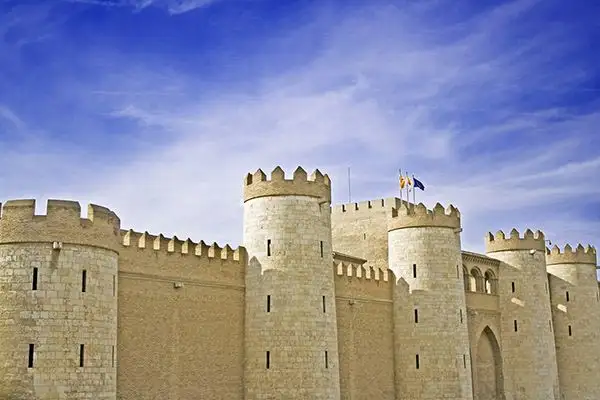
Although Andalusia is where you’ll find the majority of Spain’s most iconic Moorish wonders, many well-preserved attractions survive in other areas too. One of the most notable is the Aljaferia, an 11-century palace located in Zaragoza , the bustling capital of north-eastern Spain’s Aragon region.
Like many Moorish constructions, it eventually fell into the hands of Catholic monarchs who made their own alterations and additions. These days, it functions as the headquarters of Aragon’s regional parliament. The sheer grandeur of the site highlights just how rich and powerful the Moors were and how important this place was to their culture.
Must-sees include the ancient, five-level Troubadour Tower, Taifal Palace, Mudejar Palace, Palace of the Catholic Monarchs, Throne Room, Golden Hall, San Martin Chapel, and the Courtyard of Santa Isabel. Entry is around $5.60 but if you visit on a Sunday, it’s free.
The Alcazaba (Malaga)
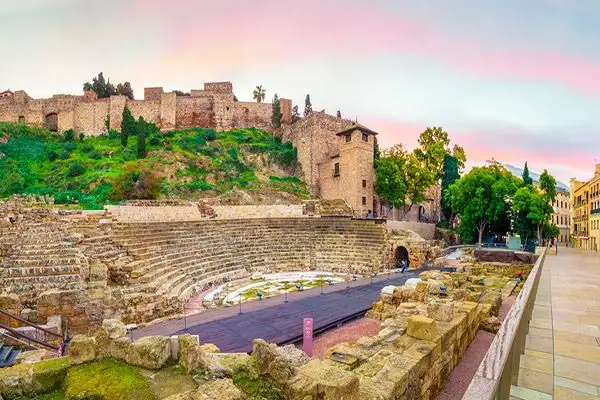
Malaga , on the Costa del Sol, is probably more famous for its high-rise resorts, yellow-sand beaches, and sun-seeking retirees than its historical architecture, but it’s got plenty to offer including a superb Renaissance cathedral and the Alcazaba, a massive hilltop citadel positioned on a lush, green hill overlooking one of the city’s most popular squares.
Originally built in 1063, it has been remodeled and refined over the centuries and is connected to the Gibralfaro Castle by a steep, walled passageway. If you’re after some healthy exercise, make your way up to the castle for a superb panoramic view of Malaga and its shimmering port.
Tickets to the castle and the Alcazaba cost around $4, with free entry on Sundays. There’s an easy-to-use ticket machine just inside the front entrance.
Off the Beaten Track

While Spain’s more famous Moorish attractions get the bulk of visitor attention, there are hidden pockets of Moorish beauty to be discovered in out-of-the-way spots too. For example, the mountaintop city of Ronda, about an hour’s drive inland from Marbella, boasts several spectacular Moorish sites.
Ronda’s Old Moorish Town is connected to the 15th-century New Town by the Puento Nuevo, a stylish stone bridge offering brilliant views of the deep El Tajo gorge. If you’re lucky enough to visit during springtime, you’ll see the entire valley covered in wildflowers.
The city’s Arabic baths are the best preserved in Spain and date from the 13th century. You’ll find them in the San Miguel Quarter—entry is $4.25. Also worth exploring is the Mondragon Palace, where there’s a municipal museum and some truly beautiful, tranquil gardens. The palace was originally built in 1314.
The gates and walls surrounding Ronda date from the Moorish era, and there’s a second palace at La Mina, where a 231-step staircase has been painstakingly cut out of the rock. In Moorish times, this led to the only water source for the city, and the steps also provided an access point for Christian troops to force their way into the city in 1485.
When you’ve had your fill of Moorish sightseeing in Ronda, check out the bullring and the river pools at the Cat’s cave (about 20 minutes’ drive from town), or make your way to one of the city’s high viewpoints (miradors) overlooking the picture-perfect valley.
The Takeaway
If you look hard enough, you can find little-known Moorish hotspots in just about every corner of Spain. The Moors legacy is evident from Vigo to Valencia and out on the Balearic islands. There’s even a stunning medieval castle on the Rock of Gibraltar that housed the area’s prison until 2010… and don’t miss the magnificent Moorish Baths in the basement of the Gibraltar Museum.
Related Articles
Tarragona, Spain: Seaside Charm and Roman Culture on the Mediterranean
10 Things to do in Llafranc, Spain
Escaping the Cold of Toronto for the Warmth of Jávea, Spain
Travel | September/October 2023
From Fabled Palaces to Ancient Medinas, a Journey Through Spain’s Islamic History
Amid snowcapped mountains, sandy dunes, a wild seacoast and more, the legacy of the country’s Moorish past can still be explored across the peninsula
:focal(2163x1751:2164x1752)/https://tf-cmsv2-smithsonianmag-media.s3.amazonaws.com/filer_public/a3/2b/a32b733f-d864-4e1e-a976-4a4920aa051f/septoct2023_n10_almeriaspain.jpg)
By Tony Perrottet
Photographs by Charlotte Yonga
It was well before dawn when I set off on foot through Granada’s oldest neighborhood, El Albaicín, an intricate brocade of cobbled streets overhung with fragrant jasmine trees. The first glow of sunlight revealed the titanic walls and turrets of the palace-fortress complex called the Alhambra looming above me on a spectacular crag. Poets have rhapsodized about the structure’s fairytale beauty since the finest craftsmen of the Arab world built it nearly 800 years ago. For over two centuries in the Middle Ages, it was the crown jewel of the Emirate of Granada, which stretched across Spain’s Mediterranean coast from modern-day Gibraltar past the snowcapped Sierra Nevada.
After crossing a stone bridge over the River Darro, I took a little-known back route into the palace called Cuesta del Rey Chico, a steep foot trail squeezed into a leafy ravine where the only sound was the water cascading from antique terra-cotta pipes. By now, the morning sunlight was making the Alhambra live up to its original name, al-Qal’ah al-Hamra , “the red fort.” An ornate archway led into the complex itself, an array of palaces and gardens covering 35 acres. The most famous site is the Nasrid Palace, named after the ruling dynasty. On my first visit, I had hardly known where to rest my eyes as I wandered its gorgeous chambers adorned with latticework and geometric patterns, its elegantly proportioned courtyards with burbling fountains, and the surrounding rose and orange gardens. Its interior walls are covered floor to ceiling with carved script in classical Arabic, which scholars have translated as praise for Allah, snippets of poetry and celebrations of the Nasrid rulers.
But on this morning’s visit, I was heading for a more mysterious world: the Alhambra’s secret network of underground tunnels and chambers.
/https://tf-cmsv2-smithsonianmag-media.s3.amazonaws.com/filer_public/f2/ba/f2bafd8e-2710-4b8c-9b1c-a53d2bf20ce9/septoct2023_n17_almeriaspain.jpg)
Subscribe to Smithsonian magazine now for just $19.99
This article is a selection from the September/October 2023 issue of Smithsonian magazine
At least, that was my hope. The Alhambra is the most popular attraction in Spain, drawing over two million visitors annually. It’s also one of the most strictly controlled thanks to its status as an Islamic outpost seized by Christians, which still has political overtones more than five centuries later. Gaining permission to visit its off-limits subterranean sections had been challenging. After emailing palace officials for weeks without response, I had already arrived in Granada when they bluntly denied my request. But then, suddenly, they reversed track. I received an urgent phone call: I had been approved to visit at 9 the next morning.
/https://tf-cmsv2-smithsonianmag-media.s3.amazonaws.com/filer_public/52/5f/525f6b0c-9bb1-4f0a-a42f-9d6bca2d5697/septoct2023_n02_almeriaspain.jpg)
After reporting at a special office to fill out a string of forms, I cooled my heels for a half-hour in the company of an affable security guard named Jaime, who was wearing an earpiece, aviator sunglasses and a black blazer with a green “A” sewn onto his lapel. Finally, Ignacio Martín-Lagos, a conservation officer, arrived and declared that he would be my Virgil to the palace’s subterráneo , a dimension of the complex that he said holds a special fascination for him. “The artistic beauty of the Alhambra aboveground is undeniable,” Martín-Lagos said in Spanish as we hopped over a metal barrier and walked along the fortress’s defensive walls. “But the most surprising thing is what lies below. It was really two structures. Only if you explore its subterranean levels can you grasp the palace’s true dimensions and understand how its day-to-day life really functioned.”
After passing a 40-foot drop without guardrails, which was not for the vertiginous, we arrived at the Torre de las Gallinas, or Tower of the Hens, where Martín-Lagos fished from his pocket a thin, six-inch-long master key. “You’re going to pass through the entire palace, but underground,” he said. After shouldering open a portal, he used his smartphone flashlight to guide us down worn stone steps into a labyrinth of tunnels and chambers once used by guards and staff. They were chilly, claustrophobic and, when Martín-Lagos turned off the light, sepulchral. But the underground was once teeming with activity, he said. “The Alhambra was a palace-city. As well as soldiers, it had about a thousand civilian inhabitants to serve the royal family—cooks, bakers, cleaners—who could go back and forth down here, without bothering the sultan. You need to have a double perspective: the ornamental world above versus the practical world below.”
I began to realize that the Alhambra most visitors see, like the Palace of Versailles and the great British manor houses, required an elaborate hidden support system. The upstairs palace offered exquisite luxury, where the sultan lounged on silk pillows and ate slices of oranges and honey cakes. Downstairs was penumbral darkness broken by flickering torches, where the staff toiled unseen to seamlessly maintain the opulence. The security purpose of the tunnels was also crucial, Martín-Lagos added, pointing up at the ceiling. We were under the room where the sultan held his audiences. “Squadrons of soldiers were lined up here, ready to rush upstairs at a moment’s notice.” Nearby was a stairway that had only been discovered after a 1907 landslide, with 200 steps descending to a door hidden in the fortress walls. We then ascended and opened a trapdoor to a bell-shaped chamber with walls of raw stone that had been converted from a grain silo to a dungeon. (Prisoners were lowered 20 feet from the surface by rope, so it was impossible to escape.)
/https://tf-cmsv2-smithsonianmag-media.s3.amazonaws.com/filer_public/49/2c/492c7e02-4ca6-433a-a053-31300bdd58d1/septoct2023_n01_almeriaspain.jpg)
The grand finale was Martín-Lagos’ favorite site. As travelers at an outdoor café in a palace courtyard snapped photographs, he unlocked two panels of a metal trapdoor in the ground and heaved them open, sending up clouds of dust. “Take care!” he said, now pointing a hefty light down a tight spiral staircase. “Take lots of care!” The electric beams cut through the darkness to reveal a vast cistern, including an ancient bucket suspended by a rope and encrusted with skeletal algae. “The major problem of the Alhambra was water,” Martín-Lagos whispered in awe. “Enormous cisterns were needed to supply the palace and its huge staff.” According to Martín-Lagos, the German traveler Hieronymus Münzer saw this cavern in 1494 and declared that it was bigger than the cathedral in his home city. “We all know that the finest engineers in history were the Romans,” he said. “That’s undeniable. But we must acknowledge the technical skill of the Spanish Muslims.”
Travelers have long regarded the Alhambra as the climax of a trip to Andalusia, as the southernmost region of Spain is known. For me, it was only the start. Just as the palace’s underground revealed the Alhambra’s inner workings, I realized that if I wanted to understand the saga of Islamic Spain, I should seek out the more far-flung and forgotten corners of the Nasrid Emirate, beyond its famous official beacon, the city of Granada, where the sultan presided in his version of the mythic Shangri-La. In fact, the Nasrid Kingdom had sprawled across an area that is today covered by four Spanish provinces. One, which extends along the Mediterranean coast, holds a special attraction for travelers: Almería.
/https://tf-cmsv2-smithsonianmag-media.s3.amazonaws.com/filer_public/14/d4/14d46d22-0fda-464c-8f1e-b8d817b39c98/septoct2023_n98_almeriaspain.jpg)
The region’s major port, Almería—which gives the modern province its name—was always of “special importance” within the emirate, says Jesús Bermúdez López, a Granada-based scholar specializing in Islamic Spain. It had been the kingdom’s lifeline to the outside world because of its geographical location, he says, “closer to the ports of the Balearic Islands, the Italian peninsula and the North African coast, with which the Nasrids carried on regular trade.”
For 21st-century travelers, though, the province of Almería has a renewed allure as one of the most spectacular and little-visited corners of Spain. Its hinterland includes the awe-inspiring Tabernas Desert, while the isolated Almería coast has largely escaped the rampant overdevelopment that has scarred much of Spain’s shoreline. Its modern core is the Cabo de Gata-Níjar Natural Park, one of the largest wilderness reserves in Spain and the pride of Spain’s extensive conservation network. Covering some 150 square miles, its coast is lined with beaches beneath headlands crowned by ruined castles, while offshore is one of the country’s most extensive marine preserves.
/https://tf-cmsv2-smithsonianmag-media.s3.amazonaws.com/filer_public/05/ee/05eef09a-b0ff-450b-9e5d-44bf3ddab945/septoct2023_n04_almeriaspain.jpg)
Even so, relatively few international travelers make the pilgrimage to the remote region. I hoped that a journey across the former emirate would also answer a historical question: Does the brilliance of Islamic Spain, which flourished in the medieval era, survive as a living presence or only as a glorious memory?
For centuries, many visitors have declared that all that remained of the medieval Arab culture in Spain were majestic and abandoned ruins. The American writer Washington Irving, who arrived in Andalusia in 1829, dismissed the Moriscos (as the descendants of the Arabs who had converted to Christianity were known) as a vanished people who had been erased from Spanish history. Irving regarded the architectural remains of the Arab world with wonder. “Never was the annihilation of a people more complete than that of the Morisco-Spaniards,” Irving declared. “Where are they?” The Alhambra, like other Islamic-era forts and walls, was an “elegant memento of a brave, intelligent and graceful people, who conquered, ruled, flourished and passed away.”
/https://tf-cmsv2-smithsonianmag-media.s3.amazonaws.com/filer_public/9c/bb/9cbbcebb-9a73-4651-913a-895cd6a03a66/spain_map.jpg)
In recent decades, scholars have taken a more subtle view, pointing out that Spain emerged from its Muslim era very different from the rest of Europe. “The Arab-Islamic culture dominated the Iberian Peninsula for almost eight centuries—practically the entire Middle Ages—and it left a great mark,” says Bermúdez López. “Al-Andalus contributed innumerable advances to humanity, in the fields of agronomy, architecture, science, philosophy, and it still remains in all aspects of Spanish daily life in food, language, topographical names.” Its influence reached far beyond the borders of Spain, enriching both northern Europe and the Arab-Islamic world stretching for thousands of miles across North Africa to Arabia. In short, Islamic Spain was a cultural conduit that shaped our modern world.
This extraordinary chapter of European history began in A.D. 711 when the armies of the Umayyad Caliphate crossed by sea from North Africa into southern Spain, which was then ruled by Christian Visigoths. The Umayyads soon conquered most of the Iberian Peninsula, which became known in the Islamic world as al-Andalus. (Christians called its inhabitants “Moors.”)
/https://tf-cmsv2-smithsonianmag-media.s3.amazonaws.com/filer_public/1c/93/1c93ff11-5e8b-4a2f-be09-ae3e96a5d8a0/septoct2023_n99_almeriaspain.jpg)
The Umayyad Caliphate ruled from the city of Córdoba for a century, turning Spain into a thriving center of art, literature and science, a florescence that continued when the peninsula was split into separate Muslim kingdoms after 1031. Its libraries contained rare copies of works by ancient Greek authors such as Aristotle, as well as Arab texts on astronomy, science and mathematics, all of which were read by scholars who made arduous trips from northern lands. The Hispano-Arab era was also known for its relative religious tolerance: Muslims, Jews and Christians lived side by side. But the caliphate fragmented around the year 1100, leaving a patchwork of Islamic kingdoms that one by one succumbed to Christian armies in a Spanish version of the Crusades later dubbed La Reconquista, “The Reconquest.”
From 1238, the Nasrid Emirate of Granada managed to hold out against the onslaught thanks to the diplomatic acuity of a leader named Ibn al-Ahmar of the Nasr family, who secured his kingdom’s independence by helping a Christian army. As a result, the glories of al-Andalus survived in this last corner of Spain for another 250 years. At the emirate’s cultural height in the 1300s, the capital of Granada was beautified by the Arabs’ advanced hydraulic engineering, filled with fountains, pools and gardens. It also boasted one of Spain’s first universities, the madrasa of Granada, and one of the country’s first hospitals, the Maristan. Along the southern coastline, in today’s province of Almería, valleys were irrigated to grow gustatory marvels unknown in the rest of Europe, like lemons, chickpeas, watermelon, oranges, eggplants and saffron. Münzer reported Almería to be an earthly paradise.
The Nasrid Emirate’s independence could not endure, as Europe in the 15th century became more religiously intolerant. Christian armies began to march on the Islamic kingdom in the 1480s, and in 1489 the port of Almería was ceded by its governor. Soon after, on January 2, 1492, the emirate’s capital city, Granada, surrendered without a cannon fired to the so-called Catholic Monarchs, Isabella I of Castile and Ferdinand II of Aragon, ending the emirate’s 275 years of independence and the near-800-year saga of al-Andalus. The power couple personally took possession of the Alhambra, taking the keys from the last Nasrid king, Muhammad XII (also known as Boabdil). In deference to the emirate’s traditions, they wore Arab robes at the ceremony and personally signed guarantees of religious freedom for all of Boabdil’s Muslim subjects.
/https://tf-cmsv2-smithsonianmag-media.s3.amazonaws.com/filer_public/b9/9f/b99f02ac-74a3-49b8-b6db-39c16ff47e96/span_king_queen.jpg)
And yet, after the Reconquest, the once-wealthy region fell into decay. By the early 19th century, it had become so wild and impoverished that Washington Irving was forced to trudge its grueling mountain roads in a mule team convoy with armed guards to protect from highwaymen. (Although the Alhambra complex was in ruin, Irving spent several months living there, listening to the songs of nightingales and the tinkling of fountains while penning his travel memoir Tales of the Alhambra , which became an instant best seller when it was released in 1832.) By contrast, I zigzagged the 100 miles from Granada to Almería in a few short hours on a comfortable local train. Rural Spain is known for its wild landscapes: In fact, Irving had felt the need to warn American grand tourists that in contrast to “voluptuous Italy,” Spain is “a stern, melancholy country, with rugged mountains and long sweeping plains, destitute of trees, and indescribably silent and lonesome.”
/https://tf-cmsv2-smithsonianmag-media.s3.amazonaws.com/filer_public/6a/e7/6ae7d464-2837-4db4-8526-1bb9961c8c0e/septoct2023_n16_almeriaspain.jpg)
My introduction to Almería, the Tabernas Desert, is the closest thing Europe has to a “pure” or genuine desert. I gazed out the train window at a parched expanse carved with bluffs and gorges. Littered at random were poignant signs of failed habitation: ghost towns, abandoned farms and ruined rail platforms. When my own train stopped, no passengers got on or off. If not for the remains of what I thought was a Roman aqueduct bleached by the sun, I might have been in backcountry Utah.
I was hardly the first to notice the resemblance. In the 1960s, this starkly beautiful landscape doubled for the American West in director Sergio Leone’s beloved spaghetti westerns, including the Clint Eastwood classics The Good, the Bad and the Ugly and A Fistful of Dollars . The cinematic love affair has extended to the rest of the province of Almería, too. Its spectacular wastes have doubled for Egypt (in Cleopatra ), Jordan (David Lean’s Lawrence of Arabia ), the Republic of Hatay ( Indiana Jones and the Last Crusade ) and Tunisia ( Patton ). It also featured in the “Game of Thrones” franchise.
“I know of no other location that has been transformed more vigorously into other places,” writes the Spanish film director Manuel Martín Cuenca in the catalog of an exhibition on cinema in Almería. “A location that, endowed with a chameleon skin, has been disguised so often and with such good fortune, fooling viewers around the world.”
/https://tf-cmsv2-smithsonianmag-media.s3.amazonaws.com/filer_public/45/a2/45a2bf7b-8146-4150-ae2f-2886e7b7973f/septoct2023_n15_almeriaspain.jpg)
The remote setting has also seen its share of violence. In 1568, more than seven decades after the Reconquest, the Muslims of Almería joined the so-called Rebellion of the Alpujarras against Christian domination in Spain, creating an outlaw Islamic enclave that held out until it was crushed in 1571. Some 350 years later, Federico García Lorca’s classic 1932 play Blood Wedding was based on a real “honor killing” in 1928, when a young couple eloped from a farmhouse called El Cortijo del Fraile in southern Almería but were caught by the family of the girl’s jilted fiancé. The boy was gunned down. Lorca himself would face an equally savage fate four years later, at the start of the Spanish Civil War in 1936, when Nationalist troops led by General Francisco Franco rebelled against the democratically elected Republican government; the writer was dragged from a friend’s house in Granada by Nationalist soldiers and executed. His body has never been found.
Soon after, a mass escape of Republican civilian refugees on the desert highway from Málaga to Almería was strafed remorselessly by Franco’s Nazi-supplied planes, leaving at least 3,000 dead. The city of Almería then became “a vast encampment,” in the words of Canadian doctor Norman Bethune, a humanitarian crisis documented by the Hungarian American photographer Robert Capa. Despite daily bombing by Franco’s air force, Almería was one of the most resilient holdouts in Republican Spain and among the last cities to surrender in 1939. It managed to endure in part because its feisty citizen-militias had dug three miles of tunnels so the entire population of 37,000 could shelter from the air raids.
/https://tf-cmsv2-smithsonianmag-media.s3.amazonaws.com/filer_public/80/5b/805ba0f7-aa55-4551-8fee-16fb7d1d83ab/septoct2023_n05_almeriaspain.jpg)
Today Almería is a sleepy provincial port surrounded by mountains that travelers often pass through quickly en route to the beaches that scallop the coast. But a little digging tells a richer story. Almería is only a short jump to North Africa—the Moroccan city of Nador 120 miles to the south is linked by daily ferries—and the Islamic past feels surprisingly close. Even Almería’s layout has the sparse geometric elegance of its Arab heritage. In the palm-fringed plaza, I ate plump olives on a rooftop across from the cathedral, which was converted from a tenth-century mosque and still has an original Islamic wall and alcove.
From there, steps ascended into the Medina, or Walled City, dating from the tenth century, a maze of narrow laneways shaded by palm trees. At its summit presides the Alcazaba, an Arab palace-fortress complex that was reinforced in the Nasrid era. Although second in grandeur only to the Alhambra, with 270-degree views of the glittering Mediterranean, it was devoid of visitors, allowing me to laze Washington Irving-style in the shady gardens, lulled by the tinkling of water running through irrigation channels by my feet.
Like the capital Granada, Almería at its height in the 1300s enjoyed urban living standards that were in stark contrast to the squalid, flea-infested world of contemporary cities in northern Europe, such as London. The ancient Romans would have been impressed by Almería’s paved, well-lit streets, fine sanitation and dozens of hammams , or heated baths. Its busy shipyard and rich silk factories funded a thriving cultural life, with the influx of foreign merchants and intellectuals adding a cosmopolitan air.
/https://tf-cmsv2-smithsonianmag-media.s3.amazonaws.com/filer_public/14/01/1401be1b-f298-4cbc-85bb-349e3496f118/septoct2023_n06_almeriaspain.jpg)
East along the coast of Almería, the route is scattered with place names of Arab origins, and at every turn of the highway the spectacular lunar landscape meets the Mediterranean with an explosion of piercing light. In the 1980s, this remote coast became the holdout of yet another quixotic rebel group: Spanish environmentalists, who for decades had been fighting a rear-guard action against real estate developers who had disfigured much of the country’s Mediterranean shore.
Created in 1987, the Cabo de Gata-Níjar Natural Park may look desolate but is far from lifeless, explains Luis Berraquero, an ecologist and mobilization coordinator for Greenpeace Andalusia. “It’s a volcanic, arid landscape, but there is enormous biodiversity in both the vegetation and wildlife,” he says. “It looks like a desert but has many endemic species, particularly wild birds. It’s a paradise for reptiles! Its offshore oceans are an underwater garden for the aquatic plant Posidonia oceanica , which has a unique capacity to filter water. That’s why the sea there is so clear for swimming and so marvelous for diving.”
Over the following week, I sought out the remotest corners of Spain’s remotest park. I had the sense of entering uncharted territory, a rare feeling in European travel today. Back home in Manhattan, I was searching without success in the New York Public Library for a detailed guidebook to this raw coastline when I came across a 1966 volume in the catalog. Produced by a certain B. Martín del Rey, the guidebook was filled with murky black-and-white photographs of solitary beaches, grizzled farmers riding horses along unpaved roads, fishermen repairing their nets, women wearing traditional Andalusian dress. Now that I had arrived in Almería myself, it was pleasant to discover that the sparsely populated coastline looked largely unchanged.
/https://tf-cmsv2-smithsonianmag-media.s3.amazonaws.com/filer_public/5d/1f/5d1fc280-6135-463a-8590-59d6c1d10829/septoct2023_n08_almeriaspain.jpg)
The whole experience took on the prelapsarian air of travel in a bygone age. I had made no hotel bookings in advance. Instead, after meandering the coast, I decided to base myself in a fishing village called Agua Amarga (“Bitter Water”), where I rented a room from an elderly lady and her daughter I met by chance on the street, both of them named Antonia. “The Two Antonias,” as I dubbed them, apologized for the room’s basic decor before showing me its terrace, which had million-dollar views over the Mediterranean.
/https://tf-cmsv2-smithsonianmag-media.s3.amazonaws.com/filer_public/a9/25/a9255d74-c950-4e90-a613-4101e6295c82/septoct2023_n14_almeriaspain.jpg)
Some stretches of the park’s coast were elemental. Although it lies over 200 miles east of the Pillars of Hercules, as ancient sailors called the Strait of Gibraltar, the North Atlantic can feel near. At the exposed Playa de los Genoveses (named for a Genovese war fleet that anchored there for two months in the 12th century), a fierce gale sent waves pounding into the sea cliffs. Other beaches offered calm waters and historical secrets. One called Playa el Playazo de Rodalquilar looked windswept at first, but the Two Antonias had instructed me to hike around the eastern headland, where I discovered a small, protected cove with gentle waters, crowned with a ruined, golden-hued fortress, the Castillo de San Ramón.
I had guessed that the castle was another Arab-era fort, but I later learned that it had been built by Spanish Christians. It was an idyllic point to ponder the cataclysmic upheavals that followed the final capitulation of the Nasrid Emirate in 1492.
That year would prove to be a pivot of world history . In January, Queen Isabella summoned Christopher Columbus to her splendid new palace in Granada and, on April 17, signed a contract funding his three-ship expedition across the Atlantic. (He set sail from Palos de la Frontera, near Seville, on August 3.) By then, the Catholic Monarchs had also reneged on their vow of religious freedom. On March 31, they ordered all Jews who lived in Spain (known as Sephardic Jews) to renounce their faith and convert to Christianity or leave the country within four months. A large percentage of the world’s Jewish population resided in the Iberian Peninsula at the time, and the result was a colossal and traumatic exodus: Around 200,000 Sephardim were forced to gather their belongings overnight and seek refuge across Europe.
/https://tf-cmsv2-smithsonianmag-media.s3.amazonaws.com/filer_public/b3/bf/b3bf9212-51df-45d7-8671-14256a40b2c2/septoct2023_n09_almeriaspain.jpg)
Today, the dramatic human history of this coast is reflected in its Spanish place names: From Agua Amarga, I drove at different times past the Rambla de los Feos (“Promenade of the Ugly Ones”), Venta del Pobre (“The Poor Man’s Hostel”) and along Camino del Cementerio (“Cemetery Road”) to Playa de los Muertos (“The Beach of the Dead”). Perversely, the most dismal appellations indicate the most seductive locations, as if Almerienses use a reverse PR to stop outsiders from finding their hideaways. After I hiked down a cliff, the Beach of the Dead turned out to be a ravishing arc of egg-shaped pebbles caressed by ankle-high waves. A pillar of stone at the beach’s south hid another secret cove with the air of an ancient sanctuary; I half-expected Jason and his Argonauts to arrive in a trireme, or the Cyclops to lumber from a cave.
Spain’s attempts at reconciliation have ranged from symbolic—a 2022 apology to women executed as witches in Catalonia—to acts that have direct contemporary impact, like the exhumation of victims in mass graves from the Spanish Civil War, offering closure to descendants who want their relatives identified and properly reburied. In 2015, there was also an attempt to deal with injustices following the demise of al-Andalus, when the Madrid government apologized for the 1492 Edict of Expulsion aimed at Sephardic Jews and offered Spanish citizenship to their international descendants. (This generous reparations bid had a setback in 2021 when some 3,000 ostensibly eligible candidates from around the world received unexplained rejections; legal cases are ongoing.)
/https://tf-cmsv2-smithsonianmag-media.s3.amazonaws.com/filer_public/00/d8/00d8f2be-ef29-472c-acdf-08de9deed488/septoct2023_n03_almeriaspain.jpg)
The promise of citizenship was not extended to the descendants of Muslims and Moriscos who were expelled in the 16th and 17th centuries, most of whom now live in North Africa. This omission reopened wounds that have barely healed since 1492. Under the reactionary regime of the dictator Franco, who ruled from 1939 to his death in 1975, Islam could not officially be practiced in Spain either in public or private—a situation that changed only in 1989. Since then, Islam has flourished. Today, there are some 2,000 mosques and 2.5 million Muslims, many converted native-born Spaniards.
Tourism is also helping the return of Arab culture. In 1998, the Hammam al-Andalus became the first Arab-style bathhouse to open in Granada in over 500 years, built on the foundations of a 13th-century hammam closed after the Reconquest. Guests drift through ornate steam rooms and candlelit hot pools, then are massaged with fragrant oils (a choice of rose, pomegranate, lavender or red amber). And Arab cuisine is enjoying a resurgence. On the last day of my trip, I returned to Almería port and stopped at a lushly colorful North African restaurant called Tetería Almedina, with tables set up in a lane beneath the vines where hummus, couscous and spiced vegetables were served. The owners were recent arrivals from Morocco who spoke to each other in French, part of the new wave of Arab immigrants who have made the return journey to Spain since the 1980s.
/https://tf-cmsv2-smithsonianmag-media.s3.amazonaws.com/filer_public/da/bd/dabd30d4-b67c-46d5-87c9-0f1114b38b21/septoct2023_n12_almeriaspain.jpg)
On a deeper level, Arab cuisine never left the peninsula: The influence of al-Andalus permeates every Spanish kitchen today in recipes and ingredients. Even paella, effectively the national dish, would not exist without Arab-introduced rice. But the complexity of the historical exchange is suggested by the ostentatious display of pork products in Spain. In Almería and beyond, almost all traditional Spanish restaurants are decorated with sides of ham dangling from the walls like enormous oily fruit. The practice dates to the 15th and 16th centuries, when converted Jews and Muslims wanted to prove to their neighbors—and agents of the Inquisition—that they were “good Christians” by displaying a product forbidden in their own religions. The writer Julio Camba argues that this is why Spain remains so pork-centric: “Spanish cooking overflows with garlic and religious prejudices.”
Not all native-born Spaniards have welcomed the return of Arab culture. The word moro , “Moor,” is still used as an insult. Meanwhile, many North African immigrants regard the centuries of Arab rule wryly. When I asked one Moroccan-born restaurateur why he had moved to Granada, he replied: “I am here to take back the Alhambra!” When Spain and Morocco faced off in World Cup soccer in Qatar last year, social media abounded with jokes: “The winner gets al-Andalus.”
/https://tf-cmsv2-smithsonianmag-media.s3.amazonaws.com/filer_public/59/82/59823d95-d717-4008-b2cc-25e235492644/028001616-28-vk.jpg)
The Granada-based scholar Jesús Bermúdez López argues that the waves of humanity passing between Spain and North Africa since the 700s are a key element of Europe’s historical wealth. “In our contemporary society, the past should be seen as something enriching, not a source of division or bitterness,” he told me in an interview. The medieval Arab legacy should be celebrated: “Not all current countries are lucky enough to be able to boast the contribution of so many cultures and civilizations through history as Spain.”
Get the latest Travel & Culture stories in your inbox.
/https://tf-cmsv2-smithsonianmag-media.s3.amazonaws.com/accounts/headshot/tony.png)
Tony Perrottet | READ MORE
Tony Perrottet is a contributing writer for Smithsonian magazine, a regular contributor to the New York Times and WSJ Magazine , and the author of six books including ¡Cuba Libre!: Che, Fidel and the Improbable Revolution that Changed World History , The Naked Olympics: The True Story of the Ancient Games and Napoleon's Privates: 2500 Years of History Unzipped . Follow him on Instagram @TonyPerrottet .
Charlotte Yonga | READ MORE
Charlotte Yonga is a photographer based in Paris and Barcelona.
- Share full article
Advertisement
Supported by
The Enduring Echoes of Moorish Spain
Exploring the country’s Arab influence is an impossibly romantic journey, involving palaces with intricate geometric designs, castles and grand mosques reconfigured by Christians into cathedrals.

By Nina Burleigh
There is a way through Spain that is all horseshoe arches, keyhole windows and bronze doors carved in Arabic script. It meanders into crenelated forts, Moorish castles overlooking the Mediterranean and grand mosques reconfigured by Christians into cathedrals.
As the child of an Iraqi woman and a Swedish-American man, I have always been drawn to places where West and East converge and dissolve into each other. The southern edge of Spain, where North Africa is just an hour away by water, is one of these places.
One midsummer week, my husband and I immersed ourselves in what remains of Moorish Spain, places that brought to mind the sights, sounds and scents of childhood visits to my mother’s homeland. We took an impossibly romantic path through Seville, Córdoba, Granada, Málaga, the port city of Tarifa and, finally, by ferry across the Strait of Gibraltar, to Tangier, Morocco.
Arab influence in Spain dates to the early 700s, not long after the founding of Islam, when Muslims from North Africa crossed the Strait of Gibraltar (from the Arabic for “Tariq’s rock”). The Europeans called the invaders Moors, after Mauretania, the Roman name for North Africa. Over the centuries, the Moors left a legacy in Spanish architecture, music, food and language in the region they then called al-Andalus. The name of Spain’s greatest hero, El Cid, comes from the Arabic honorific, Sayid. The 16th-century novelist Miguel de Cervantes framed his fictional story of the knight-errant Don Quixote as the translation of a recovered Arabic manuscript.
Where cultures meet, and endure
We started off in Seville , the capital of the south’s Andalusia region, arriving as a sunset haze made gold silhouettes of church domes and former minarets on the skyline. The slow, pale-green river that flows through both Seville and Córdoba is called the Guadalquivir — a Spanish pronunciation of the Arabic wadi-al-kabir, or big valley. Many other rivers in Spain contain the same Arabic root word for valley or riverbed, like the Guadalmedina and the Guadiana.
Early in the morning, we hit our jet lag with double espressos and bizcocho, a sweet, spongy cake, then strolled what is still called the Jewish quarter, despite the Jews’ expulsion over 500 years ago, past houses painted the colors of hay and bull’s blood, to the Seville Cathedral and the Alcázar (the Moorish rulers’ castle and gardens).
The Seville Cathedral — a UNESCO Heritage site and one of the largest churches in the world — was constructed on the site of the 12th-century Great Mosque. The cathedral’s massive blackened bronze door is carved with intricate, geometric Arabic calligraphy called Kufic and wide enough to let a team of horses through.
Throughout Andalusia, there is no clear-cut line between Christian and Muslim architecture. The Spanish Christians who eventually conquered the Moors and expelled the Muslims and the Jews during the Inquisition, starting in 1492 , didn’t tear down all the Moorish work. They applied Muslim decorative motifs to their own architecture, in a design style called Mudéjar (a word that also refers to the Muslims the Christians allowed for a time to remain) . In one convent that we visited in Seville, for example, icons of haloed saints and a crucified Christ hang under ceilings with intricate patterns of inlaid wood. The two cultures and their stylistic differences — the Islamic preference for complex geometry and the Christian depiction of living creatures — exist side by side.
A seat of coexistence and progress
From Seville, we drove east along the Guadalquivir to Córdoba, which has been called “ the ornament of the world .” Our first night in Córdoba, we woke just before dawn to a quavering wail wafting through an open hotel window. For a moment, I was back in the Baghdad summer of my childhood, sleeping on the rooftop of my grandmother’s house on little beds with mosquito nets, when the same sound would wake me in the starlit night.
Muezzins, who call Muslims to prayer, have not sounded from the Christianized minarets of Andalusia, Spain’s largest region, for centuries. But the duende of flamenco happens — and maybe not by accident — to sound much the same. Duende is a complex Spanish word that means spirit, magic, passion. It is also the name for the plaintive, wordless singing in Spain’s signature folk music.
Musicologists are unsure of flamenco’s origins. One etymology proposed by the 19th-century Andalusian historian Blas Infante is that the word flamenco comes from the Arabic words for rural wanderer. Certainly, the emotional keening evokes the human and cultural loss and ghosts of hundreds of thousands of Jews and Muslims thrown out of Spain after seven centuries of coexistence.
Córdoba’s Mosque-Cathedral, or La Mezquita, is another UNESCO World Heritage site. Here the physical and spiritual contrasts between Islam and Christianity are embedded in the walls. The massive mosque, covering nearly 261,000 square feet, was built in 784 and then expanded by succeeding generations of Muslim rulers known as caliphs. It was one of the first and grandest mosques in Europe, a forest of 856 columns supporting 365 red-and-white-striped arches. The arrangement of the pillars gives the illusion of shifting diagonal lines. The simplicity and vastness suggests an unadorned void, ideal for contemplating eternity. Standing before the one center of color, the glowing, surreal mihrab (the Mecca-facing prayer niche found in mosques), inlaid with precious stones, is like staring into the sun.
In the midst of this icon of Islamic architecture, 16th-century Spanish Catholics implanted a Gothic cathedral. Today, in the heart of this forest of arches, Christ on the cross hangs over a central nave lined with tall silver and gold candlesticks. Crowned, gilt-plaster Madonnas peek out of Islamic keyhole-shaped niches. Dozens of porticoes along the outer walls are bricked in and divided into dark, gated rooms holding saints’ bones and candlelit altars. Viewed from the top of the nearby bell tower (the former minaret, which one can climb for a few euros), an alien Gothic-buttressed spaceship appears to have landed in the middle of the roof.
Muslims are prohibited by the Catholic Church from praying inside the Mosque-Cathedral. In the early 1970s, the Saudi government offered to pay Spain millions of dollars to move the cathedral out of the mosque and construct it nearby. Spain’s former dictator, Francisco Franco, supported the idea, but the cathedral’s bishop and others opposed it, and ultimately the plan was shelved.
At its zenith, from roughly the late eighth through the 10th centuries, Córdoba was a place of unusually peaceful coexistence between Christians, Jews and Muslims. Sometimes called “la convivencia” during this period, Jewish and Christian intellectuals from all over Europe came to this Moorish seat of power, translating classical texts from Hebrew, Greek and Latin, and advancing studies of medicine, philosophy, math and astronomy.
Historians are not in full agreement about the extent of Andalusian tolerance then, and even today conflicts persist over who gets to pray inside La Mezquita. But in an interview with me over coffee, not far from the Mosque-Cathedral, the Córdoba University lawyer and historian Antonio Manuel Rodríguez Ramos argued that la convivencia was real. “Here in Córdoba, within 500 meters you find the mosque, the chapel of St. Bartholomew and the synagogue. They prayed together. The convivencia existed, and it ended when Jews and Moors were expelled.”
Besides art, language, music and architecture, the Moors left their mark on Andalusian agriculture and cuisine. Among the crops they introduced are pomegranate, eggplant, chickpeas and asparagus, which was considered a weed before they cultivated it, the white version of which is now a Spanish delicacy.
Paco Morales, a young Cordoban chef, has earned himself two Michelin stars for his restaurant called Noor — Arabic for light — on a nondescript suburban street. He serves a multicourse meal of delicacies using only ingredients available during the Moorish centuries. “I imagine myself cooking for modern day caliphs,” he said, then named one. “If Abd al-Rahman were alive today, what would he like to eat?”
A castle in the clouds
The crown of all Moorish castles is the magnificent Alhambra in Granada. It hovers above the city like a mirage, a castle in the clouds. Strolling this labyrinth of muqarna (a honeycomb-like, ornamental vaulting) and ornate white stucco walls is like a surreal trip into a giant vitrine of carved ivory. The vast complex is said to be laid out as a complicated geometric game. Evidence of an intense focus on math is everywhere. The placement of starlike patterns embedded in the arched ceilings, for example, required countless complicated calculations — by human brains, not machines.
British and American writers, including Washington Irving and Henry Wadsworth Longfellow , have waxed lyrical trying to describe the (usually moonlit) splendor of the Alhambra. Some of them even spent a night or two sleeping on tiled floors among its trickling fountains and delicate arched porticoes. We stayed in a small hotel with a Moorish-style central courtyard, called the Casa Morisca . It’s perched on a hill across from and far below the castle, where the Darro River that once sustained the great compound trickles along the outdoor cafes of the Paseo de los Tristes.
The Alhambra was the final stronghold of the last Muslim rulers in Spain, the Nasrids. Their handover of its keys to the Catholic rulers — with Christopher Columbus present at the ceremony, about to set off for the West — marked the end of 781 years of Moorish Spain. It is also a name that still resonates in the Arab world, where generations of people like my mother, a Christian raised in Muslim Iraq, grew up hearing of this storied place, but who, like her, never visited.
Below the towers, Granada bustles with university students, tapas bars and outdoor cafes, a shopping district, even a covered souk. Here you can smell the azafran (Arabic and Spanish for saffron) emanating from tiny, clear plastic containers. Only in Granada did I see tourist shops selling souvenir T-shirts with the town’s name in Arabic script.
On the steep lanes on the hill across from the Alhambra, the carmens (walled properties) of the medieval Albaicín neighborhood don’t advertise their splendid terraced gardens and stupendous views. At the very top of the neighborhood, in the Plaza Larga, a pastelleria sells the most insanely indulgent breakfast treat I’ve ever eaten with coffee — sponge cake topped with custard and filled with a milky pudding, like a tres leches cake.
After breakfast we drove to Málaga, a favorite beach destination for Britons on the Costa del Sol, and also home to one of the largest Muslim fort and castle complexes in Spain. There, we spent half a day strolling the vertiginous gardens and arched porticoes of the Alcazaba of Málaga. The compound was built by the same Moorish rulers who constructed the Alhambra, and overlooks coastal high rises, the port and the sea, and is a good, tapas-and-wine-burning hike up a mountain.
On the final leg of the journey, we drove south, as far as we could go. The outlines of the edge of another continent — the North African homeland of the original Moors, and the land to which many of the expelled Jews and Muslims fled — slowly appeared in the haze across the Mediterranean.
Passports in hand, we boarded a ferry in the little port of Tarifa, (named after the Moorish military commander, Tarif ibn Malik, and origin of the English word for import taxes, the tariff). The short, storied crossing between two continents had long been a dream of mine. For 45 minutes, I was transfixed by the waves lapping the side of the ship, thinking of the water’s role in centuries of migration and blended cultures. We left Europe behind and docked in another world, in Tangier, Morocco, an Arab city whose streets, like the Baghdad of my memory, smell of orange blossom and diesel.
Descendants of those expelled from Spain still live in the northern coastal regions of Morocco (covered in a new documentary , “Children of al-Andalus”). Some even possess real or symbolic keys to their lost houses. One of these descendants, Abdel El Akel, has a large iron key passed down for hundreds of years through the eldest male of this family. According to family lore, the first El Akel was a wealthy Nasrid builder who fled Granada in 1492 and built the first mosque in the Moroccan city of Chefchaouen. El Akel is also the name of the mosque.
Spain has offered to repatriate descendants of the expelled Jews, but it has not extended that invitation to Muslims , although some have asked. Mr. El Akel says he has no desire for Spanish citizenship. The family doesn’t even know what building their key supposedly once unlocked. But Mr. El Akel, a lean, quiet retired architect and banker who invited me to meet at his summer home near Tétouan, on the Mediterranean coast, kept his family heritage alive by educating his three children in Spanish schools from childhood. They attended universities in Spain. All three are now living and working in Granada — the first members of the family to return after four centuries.
The key stayed in Morocco.
Nina Burleigh is a journalist and author, most recently, of “Virus: Vaccinations, the CDC and the Hijacking of America’s Response to the Pandemic.”
Follow New York Times Travel on Instagram , Twitter and Facebook . And sign up for our weekly Travel Dispatch newsletter to receive expert tips on traveling smarter and inspiration for your next vacation.
Open Up Your World
Considering a trip, or just some armchair traveling here are some ideas..
52 Places: Why do we travel? For food, culture, adventure, natural beauty? Our 2024 list has all those elements, and more .
London: A writer used Camille Pissarro’s paintings of suburban London and a “lost” railway as a lens for exploring the city’s history — and settling an arcane mystery.
Dublin,: While the Irish capital has become a more international hub, locals have made efforts to ensure what makes the city unique — its spirited personality and famed hospitality — doesn’t get entirely swallowed up.
Norway: Can A.I. devise a bucket-list vacation to the Scandinavian nation that checks all the boxes: culture, nature, hotels and transportation? We put three virtual assistants to the test .
The Berkshires: A writer shares his favorite ways to experience the often-overlooked Housatonic River in western Massachusetts.
Top 9 Moorish Era Sites in Spain - Must-See Historical Landmarks & Attractions

Alhambra, Granada

Mezquita, Córdoba

The Alcázar of Seville

La Giralda, Seville
Alcazaba, málaga, generalife, granada, alcazaba of almería, aljafería, zaragoza, moorish baths of jaén, plan your trip with adventure life, want to go, top spain travel destinations.
- Canary Islands
- Douro River
- Mediterranean
- Palma de Mallorca
- Vega de Terron
Spain Trips by Departure Date
- 2024 Spain trips (51)
- 2025 Spain trips (37)
- July 2024 (23)
- August 2024 (21)
- September 2024 (23)
- October 2024 (30)
- November 2024 (21)
- April 2025 (26)
- May 2025 (19)
- July 2025 (15)
- October 2025 (18)
Top Experiences in Spain
- Spain Cruises (72)
- Spain River Cruises (21)
- Spain Cultural (17)
- Spain Luxury (17)
- Spain Food & Wine (11)
- Spain Beaches (5)
- Spain Active (3)
Spain Trips by Duration
- 8 day trips (26)
- 10 day trips (8)
- 11 day trips (9)
- 12 day trips (4)
- 13 day trips (3)
- 14 day trips (3)
- 15 day trips (4)
- 16 day trips (7)
Spain Trips by Activity
- Spain small ship cruises (41)
- Spain wine tasting (29)
- Spain archaeological site visits (20)
- Spain local market visits (18)
- Spain village visits (16)
- Spain small ship sailing (16)
- Spain urban exploration (13)
- Spain hiking (7)
- Spain land & sea exploration (4)
Why Travel With Adventure Life
Recognized by.

- Skip to main content
- Skip to header right navigation
- Skip to site footer

The Travels of BBQboy and Spanky
The Best Moorish Sites in Spain (and our favorite!)

Some of the most impressive highlights of Spain include fortresses and mosques built by the Islamic Empires (known collectively as the Moors) that ruled much of Spain from the 8 th to 15 th centuries* . The best and most famous sites are located in Andalusia, in Southern Spain, where the Moors had the strongest foothold on the Iberian Peninsula. But there are Moorish remains in all parts of Spain.
* A bit of history: – The Moors crossed from North Africa in 711 AD and quickly took over most of Southern Spain. – The height of the Muslim civilizations was in the 10th century with the Umayyad caliphate which had its capital in Cordoba. It was one of Europe’s most advanced and also more tolerant capitals where Jews, Christians, and Muslims lived together (mostly) in harmony. – At the end of the 10th century the Christian Kingdoms in Northern Spain started to work together with the goal of reconquering Spain (to be known as the “reconquista”). In 1085 they conquered Toledo, then Valencia in 1238 and then Seville in 1247. The last Muslim stronghold was Granada and that was conquered in 1492. It marked the end of over 780 years of Muslim rule in Spain.
During the almost 8 centuries of rule, the Moors left an incredible legacy on Spain’s history, culture and architecture. This post covers many of the best Moorish sites in Spain. I also tell you which is our absolute favorite.
I’ll cover 8 Moorish sites in this post but there are 3 that are absolute “must-sees” and they’re the Alhambra in Granada , the Real Alcazar in Seville , and the Mezquita in Cordoba . All are incredible and if you’re visiting Spain you can’t miss them (all are in Andalusia and relatively close together).

The Alhambra (Granada)
The Alhambra was the last stronghold of Muslim rule in Spain. In 1492, the Moorish sultan of Granada (and head of the Nasrid dynasty), surrendered his city and handed over the keys of the Alhambra to the Catholic monarchs Ferdinand II of Aragon and Isabella I of Castile.
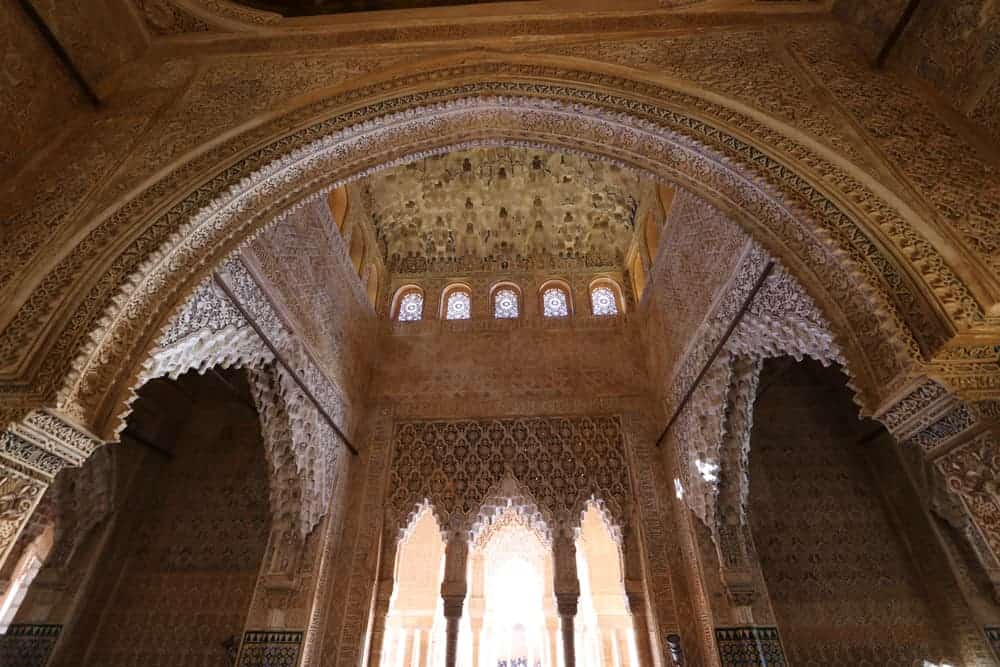
The Alhambra is a UNESCO World Heritage Site and is Spain’s most visited historical attraction. It is incredible with palaces, gardens, fortress walls, as well as an amazing location looking over the city of Granada.
See our guide to the Alhambra (on Mapping Spain, our Spain-only site)
The Real Alcazar (Seville)
The Alcazar (the word meaning “fortress palace”) was originally built as a Moorish fort in the year 712 by the first caliph (Muslim ruler) of Andalusia. The fort was demolished and turned into an extensive series of palaces in the 11th century when Seville became the capital of Andalusia. There were a total of twelve palaces which would be the main residences of the caliphs until the recapture of Seville by Christian forces in 1248. It is the level of detail – the ceilings, arches, tilework and the beautiful gardens that make the Real Alcazar such a remarkable site (and a UNESCO World Heritage Site).
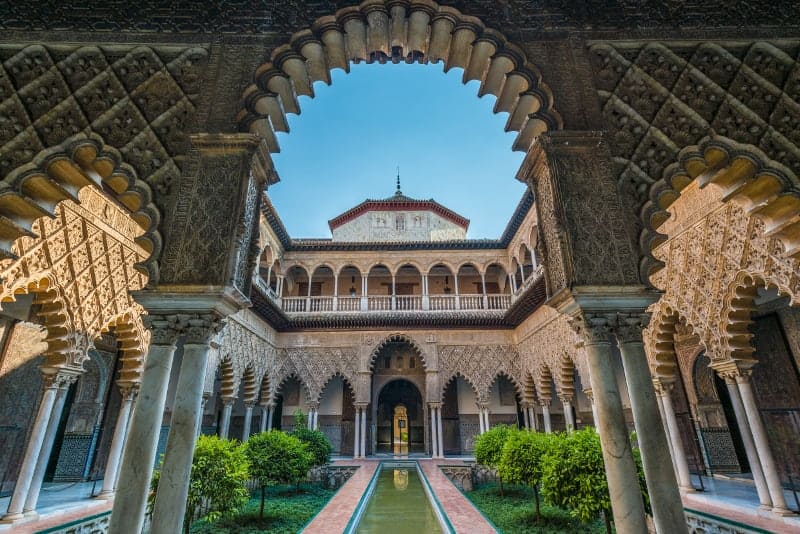
The Christian kings, much like the Moors, made the Alcazar their royal residence but made a lot of changes. It is why the complex today is a mix of Islamic, Renaissance, Gothic, and Baroque elements. Those elements make the Alcazar the finest example of “Mudejar” architecture in the world (Mudéjar is an architectural style built under Christian rule that commingles both Moorish and Spanish Christian elements).

See our detailed guide to the Real Alcazar
The Mezquita (Cordoba)
The Mosque-Cathedral of Cordoba. It is both a UNESCO site as well as one of the “ 12 Treasures of Spain ”. What makes the building so incredible are the mix of styles. The Mezquita is considered one of the two best examples of Islamic architecture in Andalusia (the other is the Alhambra in Granada). It also houses, in its vast interior, an exquisite Cathedral. While the mix of styles is confusing – and a blasphemy to some – the result is the best of both worlds in one incredible building.

More on the Mezquita of Cordoba
As I said up top, the 3 above are the top Moorish sites in Spain. All are incredible and must be visited. I’ll tell you at the bottom of this post which is our favorite.
But there are others also worth visiting…, the giralda (seville).
The Giralda is the belltower of Seville Cathedral. This impressive tower (the former minaret) is all the remains of the great mosque of Seville which stood here before it was replaced by the cathedral. What is unique is that you ascend ramps to go to the top, not stairs – It was designed this way so that officials could get to the top on donkeys or horses.

Seville. What to See – and how to do it on a budget
Medina Azahara (Córdoba)
Just outside Cordoba is the archaeological site of Medina Azahara. It was built under the orders of Abd al-Rahman III (the first Caliph of Muslim controlled Spain) and served as capital from 947 to 976 AD. Soon after the city was sacked and the city abandoned. It was only in the early 1900’s that the ruins of the city started being excavated, a process still ongoing today.
Medina Azahara is a UNESCO World Heritage Site with the inscription name “ Caliphate City of Medina Azahara “. With a museum near the site, it makes for a very interesting visit.
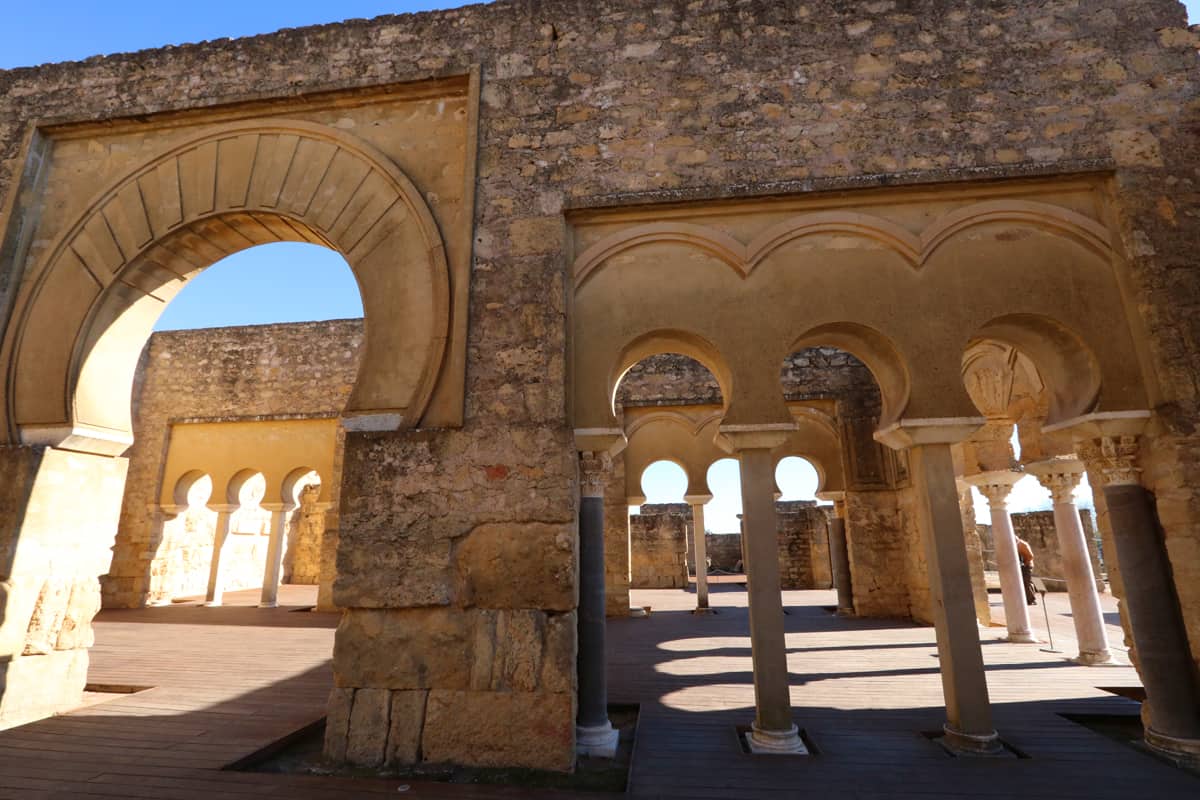
Aljafería (Zaragoza)
Aljaferia is a fortified medieval palace built during the second half of the 11th century (completed between1065 and 1081) and was one of the most northernly outposts of Al-Andalus (ie. Muslim-controlled Spain). When Zaragoza was reconquered in 1118, it became the residence of the Christian kings of the Kingdom of Aragon.
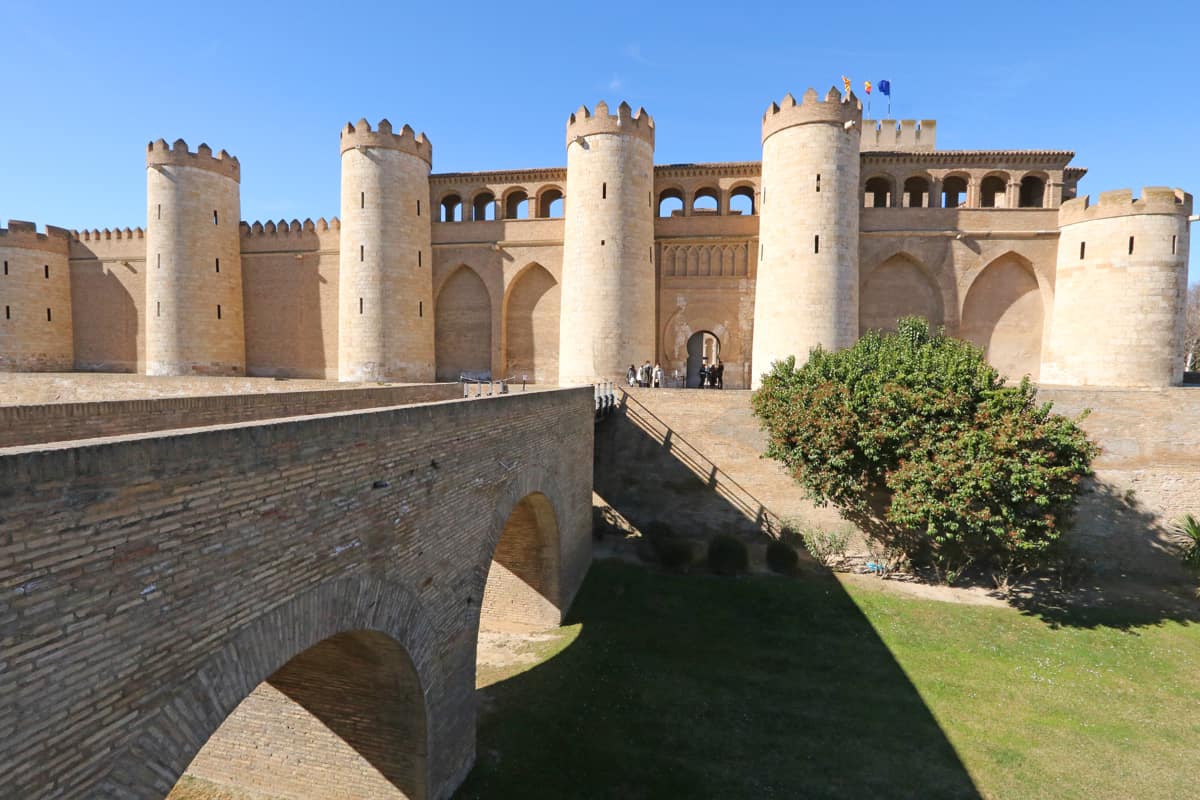
The Alcazaba and Castillo de Gibralfaro (Malaga)
The city of Malaga has 2 Moorish fortresses worth visiting: the Alcazaba (situated on a hill in the old town) and, higher up the same hill, the Castillo de Gibralfaro . Of the two we enjoyed Castillo de Gibralfaro more. It overlooks all of the city of Malaga, a heavily fortified fortress long considered the most impregnable fortress on the Iberian peninsula.

A video of Castillo de Gibralfaro
More on Castillo de Gibralfaro .
Other noteworthy Moorish sites ; Castle of Gormaz, Alcazaba in Almeria, Castillo de Sánta Barbara (Alicante), Castillo de Almodóvar del Río, Moorish Baths of Jaén, Mezquita del Cristo de la Luz (Toledo)
You should also have a look at this post which covers Moorish history, architecture, as well as some additional Moorish sites of interest in Spain.
So which is our favorite Moorish site?
It’s between the Top 3 that I mention above: the Alhambra, the Real Alcazar and the Mezquita.
We rated the Top 3 but were unsure. We visited the Real Alcazar in 2016, the Mezquita in 2016 (and again a few months ago in 2022), and the Alhambra in 2020. We thought maybe seeing them over the course of all this time would skew our perception.
So we asked our friends at Westwards for their opinion. They had come to visit us in February of this year (2022) and had visited all 3 sites within a space of a few weeks.
So how did they rate the 3 sites?
Their response:
- The Mezquita
- The Real Alcazar
- The Alhambra
Which matched exactly the order we had listed. Why? The Mezquita is stunning and made our jaw drop maybe more than any other site we’ve seen anywhere. It is incredible. The Moorish detail at the Real Alcazar is exquisite and the reason we chose it second. It is stunning. The Alhambra is incredible: the palaces sumptuous and the fortress fortifications massive and incredibly impressive.
All three are spectacular and picking our favorite among them is difficult. On a different day it could be any of the three. It just really comes down to what left us with a more lasting impression. And that is the Mezquita.
Do you have a favorite Moorish site in Spain?

Related: 30 Photos that will make you want to visit Antequera (Spain)

Related: A Travel Agent’s guide to the Best of Spain

Related: 16 Parador Hotels to discover in Spain

If you haven’t subscribed yet and want to get our posts and newsletters sent to your email, just insert your email address below
Great! Thank you for subscribing. If you don't receive a confirmation email, please check your Spam box.
Reader interactions.
July 22, 2023 at 5:37 am
Cuéllar Castle is impressively different.
July 22, 2023 at 12:26 pm
Just looking it up and it IS impressive – but from what I read it doesn’t appear to have been built by the Moors (the history a bit blurry, but the castle that stands there was actually built after Moorish rule…).
Would like to see it though, I’m a big fan of castles!
August 26, 2022 at 8:08 pm
You know, this “reconquista” thing is really a 19th century invention looking to push back a national identity as far as possible. I mean, how can some Christian kingdoms reconquest something that was never theirs? When they didn’t even exist? Pre-Moorish invasions (there were more than one) found Visigoth kingdoms, not all of them Catholic. But it was hugely important to establish a continuity between the original Visigoths and the upcoming Christian kingdoms so, in Rome’s eyes, the Christian warlords would claim it was a simple restoration so they could legitimate dynastic rights and become kings. At those times, only the Pope could crown kings and start a dynasty. Fortunately the conquerors from the north did not completely destroy Moorish culture, art, and architecture. They did try, though… (i.e. the Mosque-Cathedral of Cordoba)
August 27, 2022 at 11:57 am
Thank you, interesting perspective.
June 13, 2022 at 5:45 pm
Hi Both, thanks for your articles. My favorite Moorish site is, like yours, the Mosque in Córdoba. But that’s because it’s a punch it’s just so impressive. These days, though, it’s crammed with people aclickin’ with their phones. Which is why the second-rate places can be more enjoyable…
June 14, 2022 at 5:19 pm
We’re in agreement 🙂 It is spectacular. Bit surprised by what you say about it being crammed. We were there 1st time in 2016. Was definitely crammed then. Came back in February of this year ( Post here on our Spain-only blog) and practically had the place to ourselves.
April 18, 2022 at 1:45 am
obviously i have only visited two of these sites – the ones in Seville – but the influence is clear through this part of Spain. The one in Cordoba looks amazing! Thanks for sharing!
Leave a Reply Cancel reply
Your email address will not be published. Required fields are marked *
Notify me of followup comments via e-mail. You can also subscribe without commenting.
This site uses Akismet to reduce spam. Learn how your comment data is processed .
In the Footsteps of the Moors: Seville
Seville is a dynamic tapestry of eastern and western architecture and culture. For hundreds of years it was the capital of Moorish dynasties with Arab names like the Abbasids, Almoravids and the Almohad. This 2.200 year-old jewel has undergone just as many changes with its culture, as it has with its architecture and even its name. Let us follow in the Footsteps of the Moors and discover the best things to see in this ancient capital:

The ancient (probably Phoenician) S pal became the Latin Hispalis, then the Arab Ishbiliyya and finally, the Spanish Sevilla. While the original, Moorish architecture of Córdoba and Granada (Alhambra) remained largely unspoilt by later centuries, there’s actually surprisingly little architecture left from the 500 years of Moorish reign in Seville. The few original remains are Palacio del Yeso in the Alcázar , the city walls, the Torre del Oro and parts of the cathedral, like the main section of the Giralda – the bell tower.
But even though few original buildings are left, the Moors left an unmistakable characteristic to the city: a handicraft heritage, that was past down through generations of Mudéjars (unconverted Muslims) and Moriscos (converted Muslims) who were hired by the later kings and lords to build magnificent buildings, like the Alcázar of Seville.

After the Reconquista – the Christian reconquering of the Iberian peninsula – Seville became home to the Castilian Royals, and parts of the Alcázar are still used by the Royal family, making the Alcázar the oldest functioning royal palace in Europe. The Cathedral was built between 1402 and 1506 and converted the former Muslim minaret to a Christian bell tower, now known as the Giralda.
After Columbus had discovered America in 1492, Seville was given the monopoly for trade with the Spanish colonies in the Americas and began its Golden Age. One of the architectural legacies of this era is the Renaissance Archivo General de Indias , also on the UNESCO World Heritage list and the enormous Royal Tobacco Factory – Real Fábrica de Tabacos – that was built in 1728. The city also has many Baroque churches and buildings, which gives this ancient Moorish capital a unique architectural landscape.

Real Alcázar de Sevilla
The precursor of Seville’s Alcázar was probably founded in the beginning of the 10th century, to function as government buildings for the Caliph of Cordoba of the Umayyad dynasty. Later on, the Abbasid dynasty, who ruled Seville during the 10th century, added a new Alcázar – a Royal House – to the government buildings. The Almoravid dynasty in the 11th century closed down the government offices in order to expand the royal palace and the Almohad dynasty in the 12th century added yet more buildings to this patchwork of different Arab architectural styles.

Unfortunately, the Palacio del Yeso is all that remains from these Arab dynasties. The Alcázar you see today is actually much newer, because although the Christian monarch banned Islam when they reconquered Seville in 1248, they took the Arab design and architecture to heart and made additions to the Alcázar , that nowadays most people think are from Moorish times.
The most precious palace in the Alcázar is the Palacio del Rey Don Pedro , and this was built in the end of the 14th century by the Christian king Pedro I. To be fair – he didn’t build it. Instead, his good Muslim friend, the Emir of Granada, Muhammed V, sent his best artisans to the king and helped Pedro build the most beautiful example of Mudéjar style in the world. Remember, that Granada was still Muslim until 1492 and the alliance between a Muslim and Christian ruler was quite unusual at that time. Muhammed did owe Pedro a large favour, since the Christian king had lured the usurper Mohammed VI to Seville and cut of his head, ensuring the throne would yet again belong to Muhammed V.

The Palacio del Rey Don Pedro is popularly known as Palacio Mudéjar and here, you can find the most exquisite Mudéjar architecture such as Patio de las Doncellas, Patio de las Muñecas and Salón de los Embajadores . The other parts of the Alcázar have Gothic and Renaissance architectural features and especially the gardens are just magical. So magical, that they were used as set of the fifth season of TV-series Game of Thrones.
More information about the Alcázar:
- Official website
- Seville on Wikipedia
- Alcázar of Seville on Wikipedia
Seville Cathedral
Construction of the mosque, preceding the Cathedral, began in 1184 under the Almohad dynasty and ended 15 years later. After the reconquista , the mosque was consecrated and used as church until it was destroyed by an earthquake in 1356. Only three parts of the original Moorish structure remain: The imposing, yet light and elegant Puerta del Pérdon , which leads to the Patio de los Naranjos . The central fountain of the patio, which again incorporates a font from the former 6th century Visigothic cathedral. And the belfry Giralda , which used to be a minaret 2/3 the height of the present structure.
After the Christians reconquered Seville, they used the minaret as bell tower and when the building of the new Cathedral began in 1402, they incorporated the bell tower in the Cathedral structure. But it wasn’t until the Renaissance, that the last 1/3 was added in 1568.

The name of the bell tower comes from the weathervane statue on the top of the belfry, which in Spanish is called a giraldillo.
If you’re interested in more history about the Moorish influence on Andalucia, follow us In the Footsteps of the Moors: Cordoba , where we discover the enigmatic Mosque–Cathedral and the shady patios.
More information about Seville’s Cathedral:
- Official website (in Spanish, requires Flash)
- Seville Cathedral on Wikipedia
Learn more
Share this:.
- Click to share on Facebook (Opens in new window)
- Click to share on Twitter (Opens in new window)
- Click to share on Pinterest (Opens in new window)
Related posts

Madrid 5 Day City guide – Daytrip to Toledo

Madrid 5 Day City guide

Free Museums of Madrid
Got something to share we'd love to hear from you cancel reply.
Tourist’s Guide to Spain’s Moorish Palaces and Forts
Aug 19, 2023
Discovering Spain’s Moorish Palaces and Forts
If you’re fascinated by history and architectural marvels, Spain’s Moorish palaces and forts are a must-see. These structures showcase the rich and vibrant Moorish architecture that flourished in Spain during the Islamic rule from the 8th to the 15th centuries. Exploring these magnificent sites allows you to immerse yourself in the captivating history and culture of the region.

An Introduction to Moorish Architecture in Spain
Moorish architecture in Spain is characterized by its intricate geometric designs, decorative tiles, arches, and courtyards. It beautifully combines elements of Islamic and European styles, resulting in a unique and enchanting aesthetic. The influence of Moorish architecture can be seen not only in palaces and forts but also in mosques, cathedrals, and other significant structures throughout the country.
These architectural wonders serve as a testament to the cultural exchange and artistic brilliance that occurred during the centuries-long Islamic rule in Spain. From the ornate palaces to the grand mosques, each structure tells a story of the harmonious coexistence of different cultures.
Exploring the Influence of Moorish Culture
Beyond the architectural aspects, the Moorish influence on Spanish culture is evident in various other aspects of everyday life. From the language to the cuisine, music, and art, Spain bears the mark of this rich historical legacy. The intricate tilework, known as azulejos , found in many Spanish buildings, is a prime example of the enduring Moorish influence.
To truly appreciate the beauty and significance of Spain’s Moorish palaces and forts, it’s essential to understand the historical context and the impact of Islamic culture on the region. By delving into the stories behind these structures, you can gain a deeper appreciation for the remarkable achievements of the past.
As you embark on your journey to explore the Moorish palaces and forts of Spain, remember to plan your visit accordingly. Check out our Spain travel guide for helpful tips and recommendations on other exciting destinations and experiences in Spain.
Alhambra – Granada
If you’re fascinated by Moorish architecture , a visit to the Alhambra in Granada is an absolute must. Known as the Jewel of Moorish Architecture , this magnificent palace complex showcases the exquisite beauty and intricate craftsmanship of the Moors.
The Alhambra is a UNESCO World Heritage site and one of the most iconic landmarks in Spain. It’s a testament to the rich history and cultural heritage of the region. As you explore the Alhambra, you’ll be captivated by its stunning blend of Islamic art, architecture, and lush gardens.
Highlights of Alhambra
Nasrid Palaces : The Nasrid Palaces are the heart of the Alhambra. This intricate complex of royal residences showcases the pinnacle of Moorish craftsmanship. The intricate geometric patterns, delicate stucco work, and stunning tile mosaics will leave you in awe.
Generalife Gardens : Step into a paradise of tranquility and natural beauty in the Generalife Gardens. These lush gardens were designed for the enjoyment of the Nasrid rulers. Take a leisurely stroll along the flower-lined paths, admire the vibrant colors, and breathe in the fragrance of the blooming flowers.
Alcazaba : The Alcazaba is the oldest part of the Alhambra complex. As you wander through its fortified walls and towers, you’ll be transported back in time to the era of Moorish rule. Climb to the top of the Tower of Homage for breathtaking views of Granada and the surrounding mountains.
Palace of Charles V : This Renaissance-style palace stands in stark contrast to the Moorish architecture of the Alhambra. Inside, you’ll find the Alhambra Museum, which houses a collection of artifacts and artworks that provide further insight into the history of the region.
Court of the Lions : The Court of the Lions is one of the most iconic features of the Alhambra. This beautiful courtyard is adorned with a central fountain supported by twelve marble lions. The intricate column designs and the surrounding arches showcase the mastery of Moorish architecture.
Visiting the Alhambra is a journey back in time, allowing you to immerse yourself in the rich cultural heritage of the Moors. Be sure to plan your visit in advance and book your tickets online to secure your entry. For more travel tips and information on exploring Spain’s historical treasures, check out our Spain travel guide .
Note: The availability of specific attractions and access to certain areas within the Alhambra may be subject to change. It is recommended to check the official website for the latest updates before your visit.
Alcazar of Seville
When exploring the magnificent Moorish palaces in Spain, the Alcazar of Seville is an absolute must-visit. This architectural masterpiece showcases a beautiful blend of Islamic and Christian influences , reflecting the rich history and cultural fusion that defined the region.
A Beautiful Blend of Islamic and Christian Influences
The Alcazar of Seville is renowned for its stunning architecture, which seamlessly combines Moorish elements with Christian design. Originally built as a fortress in the 10th century, the Alcazar later underwent renovations and expansions by different rulers, resulting in a unique amalgamation of architectural styles.
As you wander through the Alcazar, you’ll be captivated by the intricate tilework, ornate arches, and serene courtyards adorned with lush gardens. The Mudéjar architectural style, characterized by its geometric patterns and vibrant color palette, is prominent throughout the palace. The intricate details and decorative motifs pay homage to the Islamic heritage of the region, creating a visually stunning experience.
Must-See Features of Alcazar
When visiting the Alcazar of Seville, be sure to explore the following highlights:
Patio de las Doncellas : This captivating courtyard showcases the epitome of Mudéjar design, with its distinctive arches, intricate stonework, and tranquil reflecting pool. Take a moment to appreciate the beauty and tranquility of this space.
Salón de los Embajadores : Also known as the Hall of Ambassadors, this grand hall is a testament to the opulence of the Alcazar. Marvel at the dazzling dome ceiling adorned with beautiful star-shaped decorations.
Los Baños de Doña María de Padilla : Descend into the underground chambers to discover the atmospheric underground baths. These fascinating structures, named after a mistress of King Peter I, feature vaulted ceilings and captivating acoustics.
Gardens of the Alcazar : Explore the lush gardens that surround the palace, filled with vibrant flowers, tranquil fountains, and meticulously manicured hedges. Lose yourself in the serenity of these peaceful green spaces.
Visiting the Alcazar of Seville is a journey through time, immersing you in the beauty of Moorish architecture and the historical significance of the region. Don’t forget to check the official website for updated information on opening hours and ticket availability before your visit.
For more information on other Moorish palaces and forts in Spain, refer to our comprehensive Spain Travel Guide .
Mezquita-Catedral de Córdoba
The Mezquita-Catedral de Córdoba is an architectural marvel that showcases the unique blend of different religious influences throughout its history. Originally built as a mosque during the Islamic rule, this magnificent structure later transformed into a cathedral after the Reconquista. Today, it stands as a symbol of the coexistence of different faiths and cultures in Spain.
A Unique Synagogue-Turned-Mosque-Turned-Cathedral
The Mezquita-Catedral de Córdoba holds a special place in Spanish history as it underwent several transformations over the centuries. Its story starts in the 8th century when the Umayyad dynasty ruled Al-Andalus. At that time, a mosque was constructed on the site of a Visigothic church. The mosque’s architectural brilliance incorporated elements from both the Islamic and indigenous styles of the region.
However, in the 13th century, Córdoba was recaptured by Christian forces, and the mosque was converted into a cathedral. The addition of a Christian cathedral within the existing mosque created a unique architectural fusion, resulting in a breathtaking synthesis of Islamic and Christian elements. The transition was carried out with utmost care to preserve the original beauty of the mosque while incorporating Christian influences.
Notable Elements of Mezquita-Catedral
The Mezquita-Catedral de Córdoba boasts several notable architectural features that deserve attention. Its most iconic element is the forest of horseshoe arches that support the roof, creating a mesmerizing visual effect. Walking through the forest of arches is a truly enchanting experience that transports you back in time.
Another remarkable feature is the mihrab , a prayer niche that indicates the direction of Mecca. The mihrab in the Mezquita-Catedral is intricately decorated with mosaics and ornate carvings, showcasing the fine craftsmanship of the Islamic artisans who worked on the mosque.
The Puerta del Perdón , a beautiful gateway, is another highlight of the Mezquita-Catedral. Its intricate design and exquisite detailing are a testament to the skilled artisans of the time.
Lastly, the Capilla Mayor , the main chapel of the cathedral, is a stunning example of Gothic architecture. Its towering columns and intricate ribbed vaults create a sense of grandeur and awe.
Visiting the Mezquita-Catedral de Córdoba provides a unique opportunity to witness the harmonious blending of different architectural styles and religious influences. It is a testament to the rich history and cultural diversity of Spain. Make sure to include this incredible site in your itinerary when exploring the moorish palaces of Spain.
For more information on traveling in Spain, check out our Spain travel guide , which covers various aspects of planning your trip, top attractions, budget-friendly destinations, local cuisine, and more!
Alcazaba of Malaga
If you’re a history enthusiast and want to explore Moorish architecture in Spain, a visit to the Alcazaba of Malaga is a must. This Moorish fortress overlooks the city of Malaga and offers a fascinating glimpse into the region’s rich cultural heritage.
A Moorish Fortress Overlooking the City
The Alcazaba of Malaga sits majestically on a hill in the city center, providing breathtaking panoramic views of Malaga and its surroundings. Built in the 11th century, this fortress was originally intended as a defensive structure and served as the residence of Moorish rulers.
As you wander through the fortress, you’ll be captivated by the intricate details of its architecture. The Alcazaba showcases a beautiful blend of Moorish and Andalusian styles, featuring stunning gardens, courtyards, and ornate arches. Exploring its well-preserved walls and towers, you’ll feel transported back in time to the era of Moorish rule.
Key Attractions in Alcazaba
Within the Alcazaba, there are several notable attractions that shouldn’t be missed. Here are some of the highlights:
Palacio de la Aduana : This palace, located within the Alcazaba, is home to the Museum of Malaga , which showcases a diverse collection of art and artifacts from different periods of history.
Patio de los Surtidores : This enchanting courtyard features beautiful fountains and lush gardens, providing a serene and picturesque setting.
Torre del Homenaje : The main tower of the fortress, Torre del Homenaje, offers stunning views of Malaga’s skyline and the Mediterranean Sea. Climbing to the top of the tower is a must-do for panoramic vistas.
Roman Theater : Adjacent to the Alcazaba, you’ll find the well-preserved Roman Theater . This ancient amphitheater dates back to the 1st century and is a fascinating archaeological site to explore.
The Alcazaba of Malaga is a testament to the rich history and cultural heritage of the region. Its strategic location, stunning architecture, and captivating atmosphere make it an unforgettable destination for history buffs and travelers alike.
When planning your visit to the Alcazaba of Malaga, be sure to check the opening hours and any entry requirements. It’s also a good idea to wear comfortable shoes, as there are some uphill paths and stairs to navigate within the fortress. Immerse yourself in the beauty and history of this Moorish fortress, and prepare to be amazed by the architectural marvels that await you.
Tips for Visiting Moorish Palaces and Forts
When planning your visit to the captivating Moorish palaces and forts in Spain, there are a few essential tips to keep in mind. To ensure a smooth and enjoyable experience, consider the following:
Planning Your Visit
Research and Prioritize : Before your trip, conduct thorough research on the Moorish palaces and forts you wish to visit. Each location has unique features and historical significance, so prioritize the ones that align with your interests. Check out our comprehensive Spain travel guide for more information on top tourist attractions and hidden gems.
Opening Hours and Tickets : Familiarize yourself with the opening hours of the palaces and forts you plan to visit. Some sites may have limited availability, so purchasing tickets in advance is recommended. Visit the official websites or consult reliable travel resources for up-to-date information.
Guided Tours : Consider joining a guided tour to gain in-depth knowledge about the history, architecture, and cultural significance of these magnificent structures. Expert guides can provide valuable insights and enhance your overall experience. Check for guided tour options on the official websites or consult local travel agencies.
Accessibility : Be aware that some of the Moorish palaces and forts may have uneven terrain or staircases. If you have mobility concerns, check accessibility options in advance or inquire about assistance at the ticket office.
Cultural Etiquette and Respectful Behavior
Dress Code : When visiting religious sites within the palaces and forts, such as mosques or cathedrals, dress modestly and respectfully. This means covering your shoulders, avoiding revealing clothing, and removing your hat. Respect the cultural and religious significance of these spaces.
Photography : While photography is often allowed in the open areas of the palaces and forts, there may be restrictions in certain sections or during religious ceremonies. Pay attention to signage and instructions from staff regarding photography guidelines. Remember to be considerate of other visitors and avoid obstructing pathways.
Quiet Reflection : Many of these sites hold historical and religious importance. Show respect by maintaining a quiet and serene demeanor, especially in areas designated for prayer or contemplation. Refrain from loud conversations or disruptive behavior.
Language and Customs : Familiarize yourself with basic Spanish greetings and customs to interact respectfully with locals and staff. Simple phrases like “hello” (hola) and “thank you” (gracias) can go a long way in establishing a positive connection.
Recommended Time to Visit
Seasonal Considerations : Spain’s Moorish palaces and forts can be popular tourist destinations, especially during peak travel seasons. Consider visiting during the shoulder seasons (spring and autumn) for fewer crowds and more pleasant weather. Check our budget-friendly destinations in Spain article for tips on saving money while traveling.
Early Morning or Late Afternoon : To avoid large crowds and maximize your experience, plan to arrive early in the morning or later in the afternoon. These quieter times allow for a more intimate exploration of the sites and better opportunities for capturing stunning photographs.
Time Allocation : Take into account the size and significance of each location when planning your itinerary. Allocate sufficient time to fully appreciate the intricate details, architectural features, and historical context. Refer to our Spain one-week itinerary for guidance on optimizing your time in Spain.
By considering these tips, you can make the most of your visit to Spain’s remarkable Moorish palaces and forts. Immerse yourself in the rich history, admire the awe-inspiring architecture, and gain a deeper understanding of the cultural heritage that these sites embody. Safe travels and enjoy your exploration of these captivating landmarks!
Find Your Next Adventure
Looking for some travel inspiration? Find your next short break, big adventure or authentic experience through Travel Gabbers

Best Fleece Lined Leggings for Cold Weather
Travel Tips
Best Fleece-Lined Leggings: Top Picks for Warmth & Comfort Leggings are staple items in many wardrobes due to...
Journey Back in Time: Experiencing the Splendor of the Pantheon in Rome
Step into history at the Pantheon in Rome. Uncover its remarkable architecture and experience the grandeur up close.
Beyond the Colosseum: Exploring Circus Maximus, Romes Historic Gem
Uncover Rome’s hidden gem at Circus Maximus! Experience the thrill of chariot races and explore the historic grounds.
Privacy Overview

~ The Rabbie's Blog ~

Where to See the Best Moorish Architecture in Spain?
I remember the first time it truly clicked with me what exactly ‘Moorish’ meant. It was in 2014, when I spent six months travelling Europe on my own. Prior to that, I’d only been to Europe once with my parents where we did the classic check-list trip. Eiffel Tower, check. Colosseum, check.
But now that I was on my own, I got to explore places that called to me. My friend and I went to Spain and visited this lovely place called Córdoba, in Andalusia. After lounging at the hotel rooftop pool with our pizza, we headed to this place called the Mezquita (‘mosque’ in Spanish) and I was immediately obsessed.
Maybe the Mezquita is familiar to you – its famous red and white arches are easily recognisable, so no wonder it draws people from across the globe. This was the beginning of my obsession with Moorish architecture, of which Spain has plenty.
First, let’s talk a bit about what Moorish even means.
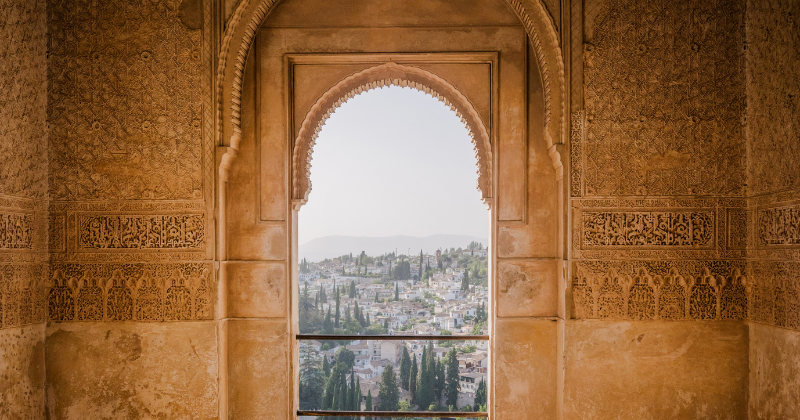
What is Moorish Architecture and Who Are the Moors?
Now, I use the term ‘more-ish’ when I’m referring to something I just can’t get enough of – like cookies, for example. But that’s not the word I’m talking about… though it kind of does apply here. I just can’t get enough.
‘Moorish architecture’ is a broad term referring to anything built by the Moors. The Moors themselves are not one defined group – rather it was the term used by Christian Europeans to describe people of Muslim descent who inhabited parts of the Maghreb and Al-Andalus in the Middle Ages.
The term itself is somewhat outdated, but Moorish architecture in Spain dates back to the 8th century. To this day, monuments built by the Moors are some of Spain’s most iconic sites.
There are several elements that make up what is known as ‘Moorish’ architecture, such as horseshoe arches. My personal favourite are their incredibly complex geometric patterns and shapes, which indicate that the craftsmen were aware of mathematics and geometry. Also, they’re just pretty. Really pretty.
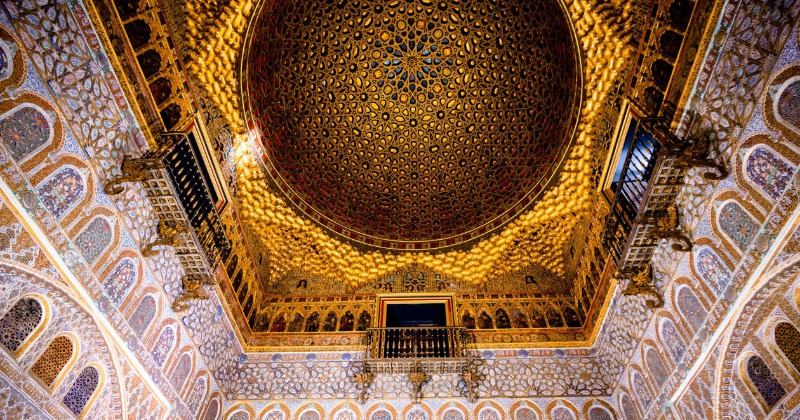
Where Can I See Examples of Moorish Architecture in Spain?
If you have plans to visit Spain, you should definitely add the following locations to your must-see list. You can see several of them on our tours of Spain .
1. Mezquita (Córdoba, Andalusia)
Starting off with my favourite – partly because you never forget your first, and partly because it was one of the first (if not the first) examples of Moorish architecture in this region. Construction began in 785-786, during a time known as the Umayyad Emirate. This was a medieval Islamic kingdom that ruled for nearly seven hundred years in what is now Spain and Portugal. The site was finished just one year later (though changes have been made to the structure over the years).
In 1236, the city of Córdoba was retaken by the Christians but luckily, they decided not to destroy the Mezquita.
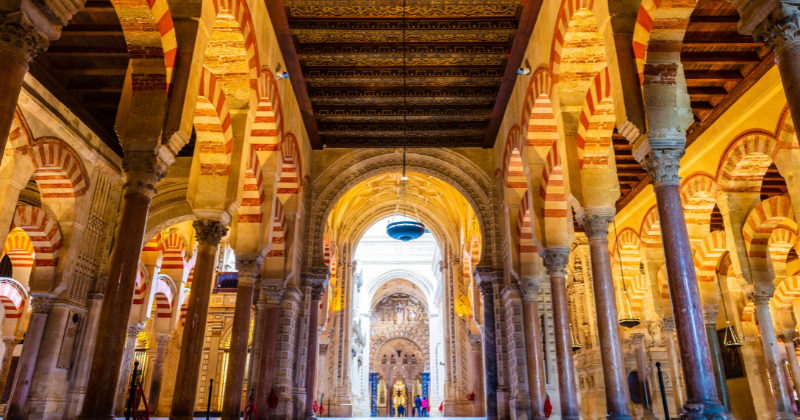
There are so many beautiful parts to the Mezquita, but it was the hypostyle hall that really got me. Hypostyle halls are enormous rooms with a roof supported by columns. In this instance, there is something about the unending red and white columns that makes you think it could go on forever. It’s honestly like stepping into another world and I was actually inspired to write a novel set in this very hall.
You can visit the Mezquita on our tours to Spain .
2. Alhambra (Granada, Andalusia)
Easily my second favourite example in Spain is the Alhambra in Granada. I’m not just going to sell you on the Alhambra, I’m going to sell you on Granada.
I’m dying to get back to Granada and stay once again in the old town, a winding labyrinth of Medieval/Moorish-inspired streets. My favourite kind of store is anything hippy – crystals, lamps, colourful clothing, incredible silver jewellery… and that is what the entirety of Granada’s old town is like.
But it wasn’t just the endless ways I could spend my money that I loved. It was the architecture, the people, and the food. Below I’ve put a little collection of my photos from the trip back in 2014. Please excuse the terrible quality, this was well before I knew how to work a camera.
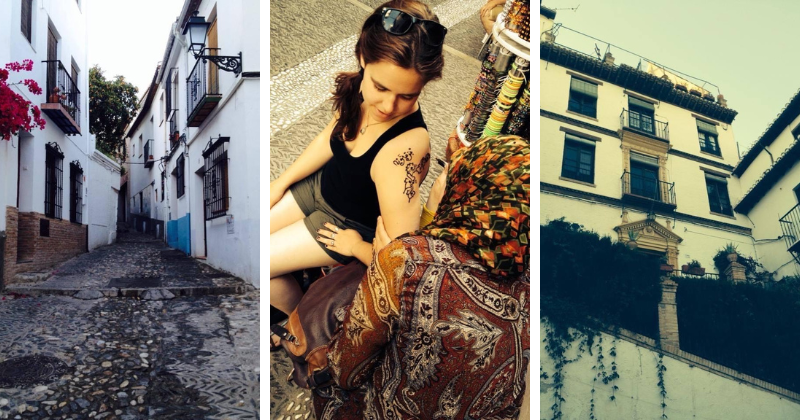
After I stuffed my face with vegetarian paella and covered myself in henna tattoos, we headed to the Alhambra. This is one of the most famous and best-preserved monuments that boasts this must-see Moorish architecture. It was built in 1238 on Sabika Hhill and, as you can see from photos, it commands the high ground and was a stronghold throughout many battles.
It wasn’t just a stronghold, however. The Alhambra is a pretty swanky building, if I do say so myself. With its lavish designs, luscious gardens, epic courtyards and water features, the Alhambra rivalled some of its famous counterparts of the era.
It’s now one of Spain’s most popular tourist attractions and is a UNESCO World Heritage Site. You can visit the Alhambra on our tours to Spain .
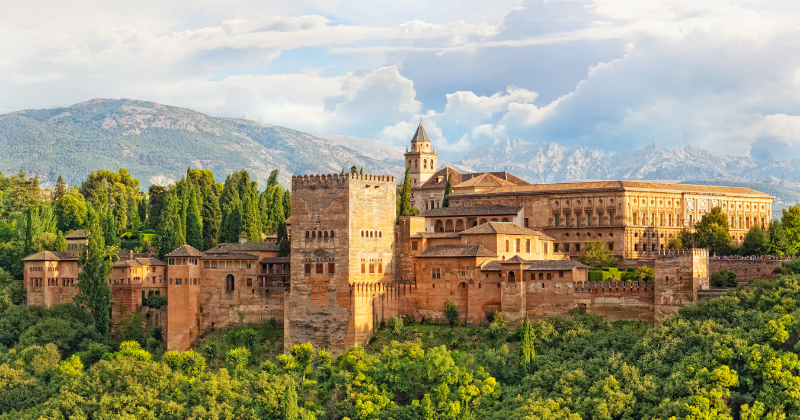
3. Torre del Oro (Seville, Andalusia)
If you haven’t been to Seville yet, I must ask what on earth you’ve been doing this whole time. Jokes aside, Seville is one of my top recommendations for those planning to visit Spain. Being both the capital and largest city of Andalusia, Seville is known for its stunning architecture and flamenco dancing.
And tapas. Always tapas.
If you jump on one of our Rabbie’s tours to Spain , you will get to spend some time in Seville. While you’re there, wander over to the Torre del Oro (“The Tower of Gold”). While many of the historic fortifications in Seville have been removed over the years, the Torre del Oro is still standing strong… which is pretty easy to do when you have 12 sides. Dodecagonal. Do-dec-ag-on-al. Boy, that’s hard to say.
Built in 1220, this military watchtower sits very prettily overlooking the Guadalquivir River, just a short walk from the Cathedral of Seville. It is well worth a visit during your trip to Seville.
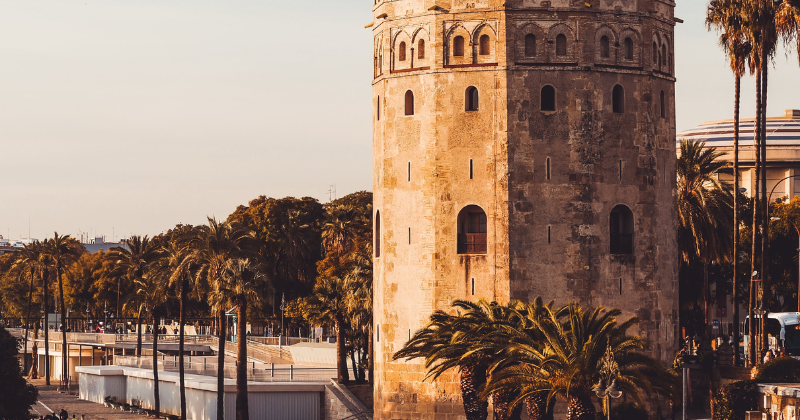
4. Alcázar of Seville (Seville, Andalusia)
If you’re visiting Seville, you can’t miss seeing the Royal Alcázar. Known for its stunning tile work, this palace was originally built in the 8th century by the Moorish rulers who occupied the area. Construction continued on and off, and in the 12th century there were further additions to make it even more like a palace. The new elements reflected the Islamic art of the time, including geometric patterns and calligraphy. This is what you will see today.
To this day, the royal family of Spain stay in the upper levels of the palace when they visit Seville, so you just know this is a site worth seeing. Not to mention you may already recongise it. Game of Thrones fans will get a kick out of seeing the palace, as it stood for the Water Gardens of Dorne in seasons five and six.
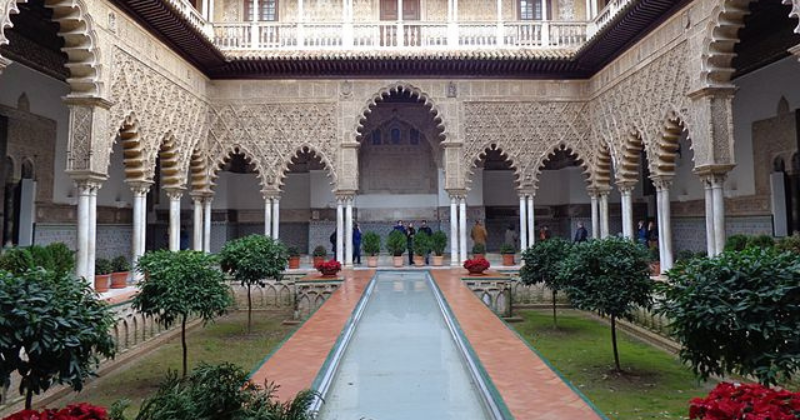
5. Alcazaba (Málaga, Spain)
Recently, I visited Spain again and it reminded me why I love it so much. Málaga was a pleasant surprise, this city is full of amazing things to do and see – including a visit to the Alcazaba. I wasn’t really sure what to expect when I arrived, seeing as I’d made no solid plans and just happened upon it. But this should definitely be on your list. Luckily, I had my camera with me and I went to town.
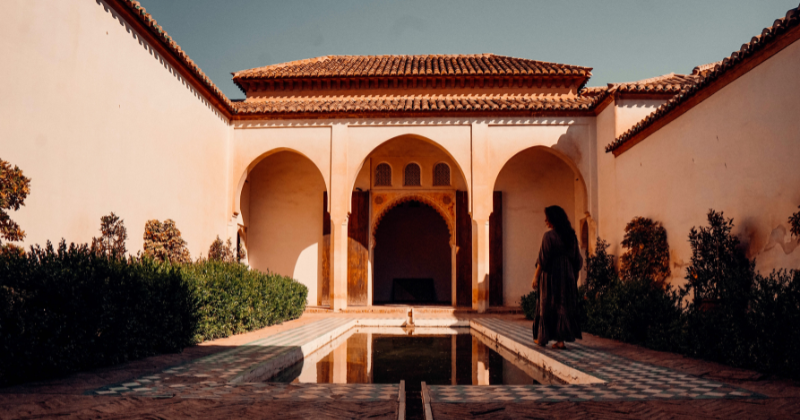
Construction on this beauty began in the 11th century and is one of the best- preserved alcazabas in Spain. What is an alcazaba? You might know it by another name – kasbah – or ‘fortress’, which is a fortified quarter of a city. While you’re humming ‘Rock the Kasbah’ to yourself, take a look at a few more photos of this stunning fortress. I’m a bit better with a camera now, so enjoy.
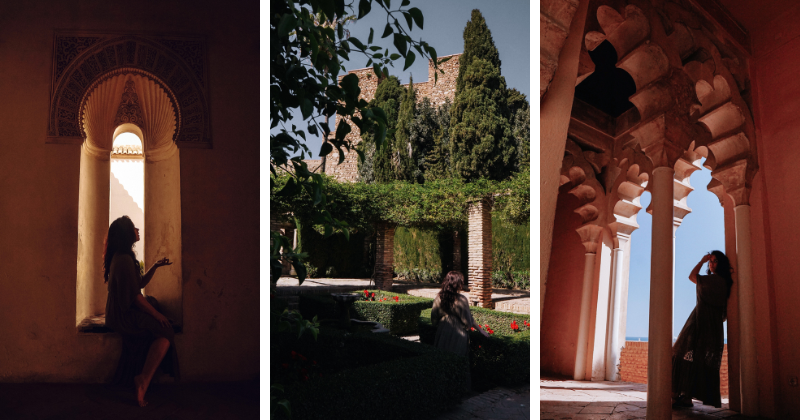
The Alcazaba is also connected to the Castle of Gibralfaro and right across from the remnants of a Roman theatre from the 1st century. There’s plenty to see, so make sure your camera is charged. Grateful that mine was, I wandered the Alcazaba marvelling at the beautiful Moorish architecture. I’m a huge fan of those iconic horseshoe arches, plus the tiling and patterns make the entire structure one stunning piece of artwork.
6. Alcázar de Jerez (Jerez de la Frontera, Andalusia)
Last but certainly not least, who doesn’t love a good palace? The Alcázar de Jerez in Jerez de la Frontera is a beautiful example of a Moorish alcázar (meaning ‘palace’). Dating back to around the 11th century, it’s now a registered Bien de Interés Cultural – literally meaning a “good of cultural interest”.
On our 6-day tour to The South of Spain & the Treasures of Andalucía , you have the option to visit Jerez de la Frontera on a half-day tour. The town itself is the heartland of sherry and Spanish brandy – so there’s more than one reason to swing by for a visit.
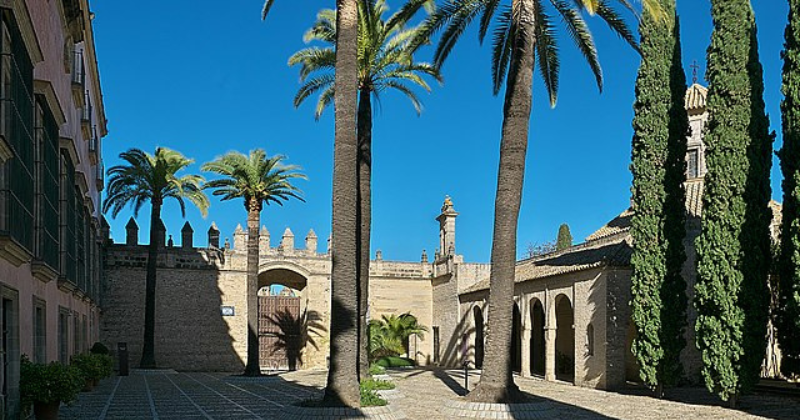
There are endless other examples of incredible Moorish architecture, so if your plan is to visit Spain anytime soon, make sure you look them up. Whether you’re catching a direct flight to Spain from the USA , doing a self-driving trip through Europe , or joining us on a Rabbie’s small-group tour , you should definitely keep an eye out for the iconic elements that make up this beautiful style of architecture.
Meet the Author

Bronwyn lives and breathes words. Before coming to work at Rabbie's, she spent 7 years in publishing and is a published author of YA fantasy books. Born and raised in Sydney, she was drawn to Scotland and affectionately calls it her 'soul home'. An avid traveller herself, Bronwyn's favourite places (so far) are Mongolia, Iceland, Morocco, and Scotland (of course). When she's not writing, she can be found exploring the Scottish Highlands with her camera, on the lookout for coos and men in kilts.
Popular Posts

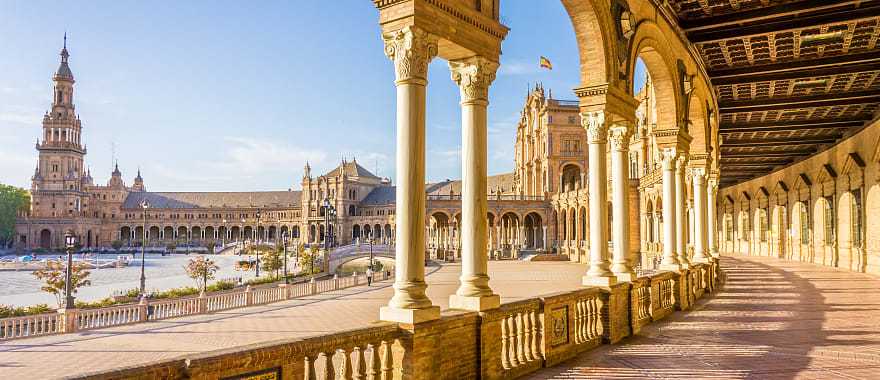
The Moors Legacy: An Immersive Historical Spain Tour
Customers rate Zicasso's travel referral service 4.9 on a scale of 1 to 5 based on 1559 reviews on Trustpilot
We match you with top tour companies that specialize in the trip you want, whether it's a customized private tour or a group tour.
- Trip Overview
This is a sample itinerary to inspire a personalized trip designed with your travel specialist
Request a Quote
Countries Visited
Places visited, suggested duration.
Magnificent yet forgotten, the Moors were the world’s great medieval civilization, inhabiting Spain from the eighth to 15th centuries. Immersing you in their history and design, this 13-day Spain tour through Andalusia celebrates the story of a civilization that redefined art and culture, the beauty of their monuments still inspiring the design of today. White villages, alcazars, mosques turned cathedrals, Mudejars, and Moriscos; you find charm and soul in the south of Spain.
Customizable Itinerary
Madrid – arrival in spain.
Fly to Spain’s largest international airport, and spend the night in the capital at your hotel that is within walking distance of the grand Plaza Mayor (central square) and an assortment of cobblestone streets. From Madrid, it is a short journey by high-speed train to Cordoba, and the capital makes for the most convenient place to start and is a relaxed introduction to Spain. Explore at leisure, embracing your first flavors of the country, such as chocolate and churros or al fresco tapas terraces. The immersive historical tour starts tomorrow, but today is focused on relaxing and tuning your footsteps into the languid Spanish pace.
What's Included:
Cordoba – The Mezquita – A Centerpiece of Moorish Brilliance
Every world century has a defining city of culture. Athens, Rome, Florence, and Cordoba. The Caliphate of Cordoba expanded from the late eighth century. The people, religion, and culture come from across the water and North Africa. In the ninth and 10th centuries, Cordoba was the soul of world culture, with the elaboration of art and design far exceeding what was being created elsewhere in Europe. One building symbolizes the time and the Moors, the Mezquita a perfect introduction to this private tour, an eighth-century mosque wrapped around a 16th-century cathedral, framed by mythology and mesmeric design. It has changed over the centuries, and your guide helps provide a historical walkthrough, the evolutions epitomizing how the Moors also changed over time.
The remains of a Visigoth church wall indicate what came before, although it can be hard to focus on this detail when you are confronted by 850 granite and marble columns that sustain the roof in the center of the Mezquita. Intricate calligraphy twirls around prayer niches, golden leaves inhabit the corners, the work of both Mudejar and Morisco artistic schools comes alive on a grand scale. Then there is what came next when this Grand Mosque became a working cathedral. Take the train to Cordoba and meet your guide for lunch, before the afternoon is dedicated to this exceptional and most important of all Moorish sites. The evening is at your leisure, and this once great city retains much evidence from its time as a cultural pioneer.
Cordoba – Brilliant Remains from the Time of the Caliphate
The remains of Cordoba are alive in both its architecture and atmosphere. Artisanal stores continue to dot the maze-like lanes of the center, shouts, and smells ring out across traditional marketplaces, and small squares have the quaint feel of centuries past. Most people who stop here come only for the Mezquita, but look further, and you get a real sense of early Moorish culture. This is the city from which the caliph once ruled over the entire Iberian Peninsula. With an expert guide, the streets come alive, particularly the remnants from the eighth to 11th centuries that stretch out beneath the looming walls of the Mezquita. Complete a relaxed day of exploration with a dinner at a restaurant on Plaza de los Capuchinos, where wrought-iron lanterns illuminate the scene.
Seville – Treasures Built upon Treasures in Vibrant Seville
Exuberant Seville is a fusion of styles, a city from Moorish times that flourished when it was granted exclusive port rights for ships going and coming from the New World colonies. The whitewashed harmony of the walls holds the city’s contrasting artisanal styles together and is probably the oldest legacy from the Moors. Take the train here and spend the day experiencing the city’s unmissable attractions, including the Gothic cathedral, the Museo de Bellas Artes, and a horse-drawn carriage ride between the plazas. While it is not Moorish, the art form of flamenco comes from Seville and is an option for the evening, along with what is arguably Spain’s best traditional tapas experience, hopping between bars in the area of El Arenal.
Seville – Exploring the Work of the Mudejars
Mudejar intricacy embellishes buildings all across Seville, and the Royal Palaces are a grand place to start exploring the style. When the Christian monarchs of the north gradually took over the Moorish lands, the Moorish people stayed. Unlike the Moriscos, the Mudejars retained their religion, their name coming from the Arabic mudajjan (literally “allowed to stay.”) From the 12th to the late 15th centuries, their artisanal brilliance was much sought after, elevating the drab and bulky Romanesque styles that were favored by the church. From the Royal Palaces, you take a walk through the city, admiring hidden remains of emblematic Mudejar style: seductive calligraphy, archways of color, tiles of blue framing bars selling ice-cold sherry, and alleyways that you can walk a dozen times and always notice something different.
Arcos de la Frontera – A Parador in a Classic Pueblos Blancos
From the cities of grandeur to the villages of white, you take a drive across the hills of Andalusia, where the Pueblos Blancos cling adoringly to the tops of cliffs. The Moorish rule was not always a time of peace, with raiders and pirates coming across the Mediterranean on looting missions. When the caliphate ended, a period of unrest meant the raiders also came from inland, so the Moors built their villages in the hardest to reach places, on the highest of peaks, where no intruder could arrive unannounced. Arcos de la Frontera is the classic Moorish White Village, seductively small and peaceful, particularly when day-tripping visitors have left and you enjoy a night in one of Spain’s best paradors , a castle turned hotel that completes your immersion into the village’s history.
Ronda – Spectacular White Villages Untouched by Time
The road to Ronda passes two small Pueblos Blancos, ascending through olive trees to villages that you can walk around in 20 minutes, but you could spend two hours inspecting all the details. Untouched by time and enhanced by their dramatic location, these villages have an almost fairytale ambiance. Today’s relaxed drive takes you east across Andalusia, through the mountains to Ronda, the oldest and most spectacularly situated of the white villages (and also a city with Greek heritage). Spend the afternoon exploring with the guide, the iconic Moorish style interspersed with Renaissance design and a look at Spain’s most famous bullring.
Malaga – Remains of the Ancient Moorish Port City
While the work of the Mudejars and Moriscos tells what evolved after the Moors, Malaga starkly presents what came before. A Roman amphitheater stands above the Mediterranean, thick slabs of stone flowing beneath a rustic Moorish castle. This was the Moors’ port, and the fortress is thicker and more imposing than any other, built to ward off the continual marauders. As the guide takes you through the castle, you discover how it is mostly built upon a Roman castle. What remains here is crumbling, disintegrating in the salty air, wonderfully archaic in its outward appearance. Later in the day, you will also discover Malaga’s other highlights, as this is the city where Picasso spent his formative years and where much of his early work is presented.
Granada – A Cathedral Castle and the Final Stronghold of the Moors
Even larger than Malaga, the fortress of Almeria continues your immersion in a time of rebellion and raids. In this small town, you will also find a gypsy quarter where locals live in caves and the whitewashed stone of an old city that appears as if it was permanently under siege. It is a stop en route to Granada, the second great city of the Moors. After the caliphate in Cordoba came a time of individual Moorish kingdoms, with only the Nasrid Kingdom continuing beyond the end of the 13th century. Granada was the base of this kingdom, and it held strong until 1492. While Cordoba looks like a postcard, this final Moorish bastion is rough and rugged around the edges, creating an allure that symbolizes its peculiar history.
Tomorrow, you can see the famous sights, but today, you get to wander the narrow, hilly streets where the stirring of the counter culture and modern Arabic prose mingle with the poetry of the old gardens and palaces. It is a city of fable and fiction, one that implores you to turn another corner and seek out the treasures that hide in the shadows. Granada is a city with an atmosphere, one that allows proud history to mingle with the vibrancy of today. During the evening, you have the chance to explore some of the many little tapas taverns, nationally regarded as having some of the best food in Spain.
Granada – Exploring the Legacy of the Nasrid Kingdom
The Alhambra looks magnificent in the morning light, the sun reflecting gently off the golden walls. Head inside, following the fluted columns to the magnificent geometric details on the ceilings. From the outside, this is an imposing fortress, the design dominated by the need for defense. On the inside, it is all charm, such originality in the ascetics and gardens. Continue the inspirational look at history as you explore the white walls that surround exotic gardens of North African flora, then feel the relics of history as you try to make sense of a city that is dominated by riddles. Other than the Alhambra, nothing is clear-cut in Granada, creating a city as enigmatic as any in Europe.
Day 11 - 12
Ubeda and Baeza – Brilliance of the Moriscos: Renaissance Design Enhancing Medieval Moorish Ideas
For the last ten days, you have mostly explored the artisanal brilliance of the Moors and the Mudejar, a style firmly vested in Islam and tradition. Spending two days in Ubeda and Baeza, you are immersed in the legacy of the Moriscos, Moorish descendants who converted to Christianity around the time of the Reconquest (some of them forcibly). They were inspired by the same artistic and architectural foundations, like love for symmetry, a passion for details, and the ability to use white for elaborate features to fully stand out. In these two World Heritage cities, the Moriscos added a strong scent of their newly found religion, importing the exciting idea of the Italian Renaissance to Spain.
The results are rare and beautiful, with only a small semblance of commonality with the other places you have visited in Andalusia. Palatial mansions are dotted with swirls of color, cherubs look on from the churches, and winding white-washed lanes are sprinkled with the soft hues of the Renaissance. A hospital is flanked by a spire laden with blue and white tiles, plazas seem halfway between the Middle East and Italy, and elaborate figures line the archways of cathedrals. You will spend the evenings in Ubeda, staying at a grand parador in the heart of the city. On day 12, you make a trip to Baeza, a city just nine kilometers away, entered through a gateway that has not been touched since the 16th century.
Granada – Departure
To leave Andalusia, you transfer back to Granada by road, site of the closest airport to Ubeda. Crossing the plains of Andalusia, you wave farewell to the land of the Moors, a tiny village glistening on a distant hill. From Granada, you board a plane destined for Madrid where you connect with your international departure.
Trip Highlights
- Admire some of Europe’s finest architecture, like the Mezquita in Cordoba and Alhambra in Granada, epic legacies to the artisanal brilliance of the Moors
- Lose yourself in Cordoba, where a lot remains from the first Caliphate when the city was the most cultural on the planet
- Explore how the Mudejars added treasure upon treasure, their intricate design etched all over the city of Seville
- Compare the Mudejars to the Moriscos, who added the style of Italian Renaissance to Eastern design in the cities of Ubeda and Baeza
- Spend two days journeying through the Pueblos Blancos, charming whitewashed villages that cling to the hills, and be taken back to a time when Moorish communities battled raiders and pirates
- Discover the alcazars of Almeria and Malaga, fortresses and palaces rolled into ancient structures so iconic in design
- Become immersed in the final Moorish stronghold, with two days in Granada revealing the relics of the Nasrid Kingdom
Detailed Description
Not much has survived from Europe’s medieval centuries. Battles were waged, innovation stalled, art was at a standstill across most of the continent. After the Greeks and the Romans came a period of seeming nothingness, before the explosion of the Renaissance and the Gothic. This interpretation of medieval Europe is one-sided, overlooking one of the greatest civilizations ever to grace the planet, the Moors. Once powerful, now mostly forgotten from world history, the Moorish realm stretched across the Iberian Peninsula (modern day Spain and Portugal). Cordoba is its beating heart, the world’s most cultural city in the 10th and 11th centuries. When their lands were taken over, their legacy continued, the Moriscos and Mudejars dictating artistic ingenuity up to the 16th century. In the 21st century, spectacular examples of Moorish culture continue to cover the southern Spanish state of Andalusia, and the experience is immersive, cities and villages hardly changed since the medieval era.
This privately guided 13-day tour celebrates the beauty and bequest of the Moors, exploring the less than subtle contrasts between the centuries, as well as the brilliant diversity of the designs. Starting with the time of the caliphate in Cordoba, the Mezquita is a mesmerizing introduction to the art, and you take a journey across the Moorish memoirs in Andalusia. Spend two days in the Pueblos Blancos (White Villages), Arcos de la Frontera and Ronda an immersion in the whitewashed style of Moors evading looters and pirates. Take in the cathedral castles of Malaga and Almeria and how the grand design is built upon what the Romans left behind.
In Seville, you spend two days exploring the legacy of the Mudejars, Islamic people of Moorish descent who stayed in Andalusia following the fall of Cordoba and the caliphate. Later, on this exclusive Spanish tour, two days in Ubeda and Baeza present the brilliance of the Moriscos, Moorish descendants who converted to Christianity, fusing influence from Renaissance Italy in their sought-after artisanal designs. Granada was the final Moorish stronghold, surviving until the year Columbus reached the New World, and two days in this labyrinthine city are an insight into the old world of the Nasrid Kingdom. Guided by a Moorish expert and afforded the time to ensure a leisurely pace, this is an illuminating journey through one of the world’s greatest cultures, and a history that deserves far more international recognition.
Extend your tour to Spain by seeing the other ways you are able to customize your Spain itinerary.
Starting Price
$4,051 per person (excluding international flights)
Your Zicasso trip is fully customizable, and this sample itinerary is a starting place for your travel plans. Actual costs are dynamic, and your selection of accommodations and activities, your season of travel, and other such variables will bring this budget guideline up or down. Throughout your planning experience with your Zicasso specialist, your itinerary is designed around your budget. You can book your trip when you are satisfied with every detail. Planning your trip with a Zicasso travel specialist is a free service.
What's Included
- Accommodations
- In-country transportation
- Some or all activities and tours
- Expert trip planning
- 24x7 support during your trip
Your final trip cost will vary based on your selected accommodations, activities, meals, and other trip elements that you opt to include.
Reviews of Zicasso's Referral Service
4.92 stars based on 2326 reviews.
Reviewed By Jim K.
Reviewed By Ernest M.
Reviewed By Caren F.
Reviewed By Donna K.
Reviewed By Mimi k.
Reviewed By Phyllis P.
Expert Tips for Discerning Travelers
Your Dream Vacation
in 3 simple steps
Describe your dream trip
Get matched with top travel specialists
Book the trip
Help Me Plan My Trip
Free service - no credit card required


Spain As We Know It, Thanks to the Moors
S trolling through the southern Spanish city of Sevilla on a sunny early spring day, the sweet smells of orange blossoms surround you as they waft through the air. These fragrant fruit trees flourish in the cobble-stoned streets and bring color to the beautiful Royal Alcázar of Seville .
This picturesque sight wouldn’t be possible if it weren’t for the Muslim kings that reigned over the Iberian Peninsula for centuries. Unbeknownst to many, several of the most quintessential Spanish cultural icons we cherish today can trace their roots back to a mighty Moorish nation called al-Andalus .
The Moor’s Rise and Fall
History has largely painted over the cultural and scientific contributions that the Moors had in Europe. They ruled over the Iberian Peninsula, parts of France, Malta, and Sicily for more than 700 years.
When the old Roman gods were forgotten, many countries had already converted to Catholicism. However, the Catholics coexisted with a large and powerful Muslim kingdom that exerted great control over Europe. These two religions clashed often but they also shared ideas, cooperated, and influenced each other in a way that seems almost impossible today.
By 1492, the Moors were defeated in the Reconquista , making Spain Catholic once again. Over the next decades, their population was driven out completely by the gruesome Spanish and Portuguese Inquisitions. Now, all these centuries later, their way of life, art, and ideas have left an obvious mark on the Spain we know and love today.
Their impact was so extensive, the Moor ’s have left their shadow on modern Europe and western culture as a whole.
Rich and Flavorful Food
The shock of fragrant yellow rice is the unmistakable centerpiece of a mouthwatering, authentic Spanish paella . It owes its unique golden tinge to a rare and expensive spice, called saffron . Both saffron and even rice itself, a staple of Spanish cuisine, was introduced and cultivated in the region by the Moors .
Many fruit trees, such as apricots, peaches, pomegranates, lemons, and date palms are now key Spanish exports, also originally brought over by the moors . These additions have given Spanish food its zest and color.
Islamic Architecture
Moorish architecture is a great example of classic Islamic art. Its buildings are categorized by horseshoe arches, motifs inspired by vegetation and nature, borders of calligraphy, narrow columns, reflecting pools, and beautiful tilework. Some of Spain’s most beloved and visited buildings were built by the Moors .
The best-preserved Moorish fortress is the Alcazaba of Málaga, home to trickling fountains, romantic gardens, and a stunning panoramic view of the coast and the Mediterranean Sea. The Royal Alcázar of Seville is frequently used as a film set, seen in Game of Thrones and Lawrence of Arabia, due to its idyllic courtyards.
The Catholic Mosque
Córdoba was the capital of al-Andalus and was the most modern city in Europe at the time. Hygiene and safety were a chief concern. It had more than 900 baths and paved, platformed sidewalks and bright street lamps hundreds of years before any other European city thought to use them.
Rising high above the flowing Guadalquivir River are the towers of the La Gran Mezquita (The Great Mosque), considered the finest example of European Moorish architecture. Completed in the 17th century, it was split in half for several decades in the 700’s, with one section for Catholic worship and the other for Muslims. This peaceful negotiation was halted by the year 784 when it was converted into a mosque. When the Catholics conquered the city in 1236, they converted this historic building into its current status as a Catholic Church.
Statues of Jesus and Catholic saints are proudly displayed next to Islamic style horseshoe arches, surrounded by borders of calligraphy with verses from the Koran, and a large columned praying hall instead of pews. This juxtaposition of two major religions is a prime example of the complex cultural history of Europe and is uniquely Spanish.
La Alhambra
The stunning Alhambra sits atop a hill, watching over the charming Andalucian city of Granada . This city was the last stronghold of the Moorish kingdom. In 1492, when Granada ultimately fell after a brutal ten-year war to the Catholic Monarchs, Isabel and Ferdinand, their rule in Europe had finally come to an end. The city and its marvelous fortress-palace, the Alhambra, was surrendered.
Rebuilt to its current glory in the mid-13th-century, Alhambra is the Arabic word for the red one, named after its warm-toned stones that shine with the sunset. The chirping crescendo of the nightingales that call it home echoes through its numerous courtyards. Keyhole arches with intricate tiles open into gardens with blossoming flowers, fragrant fruit trees, and the relaxing trickle of running water flowing from the reflecting pools and adorned fountains.
After falling into disrepair throughout the centuries, it was eventually rediscovered and romanticized by British and American travelers in the 19th century. This newfound interest encouraged crucial renovations that helped make it the most visited monument in Spain today.
Language and Education
Although you may still spot Roman Numerals at the end of some fancy names (think Henry VIII), modern society has almost completely replaced them with the Arabic Numeral system. Education was highly valued in Moorish society and they were the first European kingdom to use the numeral system we all know today. In fact, algebra is even an Arabic word.
Complex equations are much quicker with Arabic numerals and neighboring countries quickly adopted the system. This caused science and math to improve in Europe and laid the groundwork for a scientific revolution.
Since the Catholics and the Moors lived side by side for so many centuries, many Arabic words and expressions have been adopted into the Spanish language. In Hispanic countries worldwide, you will hear people saying “ Ojalá ”, which means hopefully . This comes from the common Arabic expression, “ ma sha Allah ”, meaning “ God will it ”.
The Renaissance
At a time when the entire European continent had only two universities, the Moors built 17 prestigious universities in Spain alone. The founders of both Oxford University and The University of Paris were inspired to bring higher education to their countries after visiting the Moorish kingdom.
This interest in education for everyone spread throughout Europe. The European Renaissance began around 1300 AD and the Moors were in power until 1492. Their scholarly pursuits had a direct influence on the beginnings of this crucial movement that inspired some of history’s greatest thinkers. When Cervantes wrote the first modern novel in the early 15th century, Don Quixote , he told it from the point of view of a fictitious Moorish author.
On your visit to Spain, keep an eye out for Moorish influences, you might be surprised by what you find. Many travelers are drawn to them since they stand out from much of the European styles.
Book Now to Stay in Seville, Spain
Search, compare and book hotels & rentals at the best prices from major booking sites like Booking.com, Hotels.com, Expedia, Vrbo and more. You can move the map to search for accommodations in other areas and also use the filter to find restaurants , purchase tickets for tours and attractions and locate various points of interest!

Deals of the Week Must-haves for 2025 Up to 50% OFF
Moorish Andalucia
No departure dates available.
No dates, no problem! Subscribe to our newsletter to receive:
- Travel inspiration for similar adventures
- Alerts of the newest adventure deals
By submitting this form, I agree to the TourRadar T&Cs and Privacy policy .
You have successfully subscribed to our newsletter, check your inbox!
It seems you have entered this contest already! Keep an eye on your inbox for the winner.
- In-depth Cultural
- Fully Guided
Traveled in September 2023
Places You’ll See
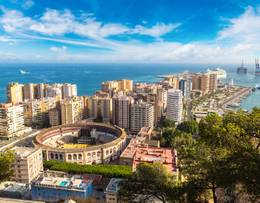
- Walk through the royal palace of the Alcazar
- See the remarkable arcaded hall of Mezquita
- Meet the locals at an authentic mountain town
- Gaze at limestone peaks surrounding 'Pueblo Blanco'
- Introduction
- Day 1 Join trip in Malaga
- Day 2 Take a train to the white hill town of Ronda and take in views of the gorge
- Day 3 Visit the white villages in Sierra de Grazalema Natural Park
- Day 4 Travel to Seville and discover the city on foot
- Day 5 Visit Alcazar and explore Seville
- Day 6 Travel to Cordoba by train and Mesquita Mosque guided visit
- Day 7 Bus to Granada via Cabra village
- Day 8 Visit the Alhambra Palace including the Nasrid Palaces
- Day 9 Morning public bus to Malaga. Afternoon free to explore
- Day 10 Trip ends in Malaga
Want to read it later?
Download this tour’s PDF brochure and start tour planning offline
What's Included
- Accommodation
- Additional Services
Customer Photos
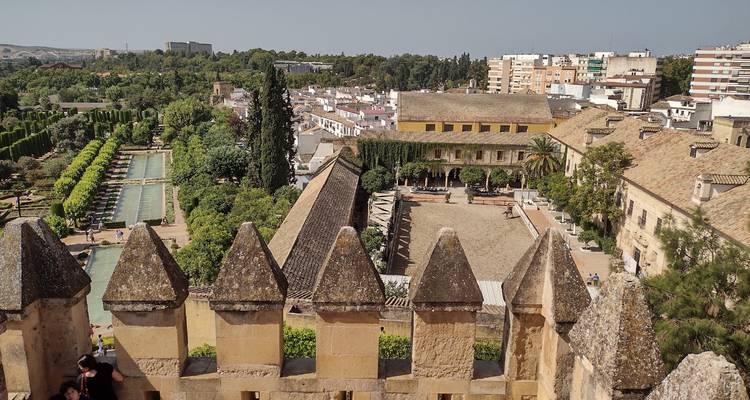
Operated by Explore!
Explore is a global adventure travel company with 42 years’ experience in providing exciting and...
Sustainability Initiatives
Reduce Carbon Emissions
Animal Welfare
Supporting Destinations
Sustainability Programs
Your Peace of Mind Options
Cancellation policy.
A transparent overview of applicable fees.
Customer Reviews
- Overall Rating Excellent 4.2
- Itinerary Excellent 4.4
- Guide Excellent 4.4
- Transport Good 3.8
- Accommodation Good 3.9
- Food Good 3.8
- Tour Operator Explore! 4.5
- Most Recent
- Most Popular
- Highest First
- Lowest First

- A Richard · 27th April 2023 A very cultural trip with the provision of excellent guides. Trip date: April 2023 Review collected by Explore!
- A Audra · 27th April 2023 All of the included attractions were well worth the visit and having 2 private tour guides was a fantastic addition. Siri did her best to wrangle our group and gave us good information about the region as we traveled. But it was hard for her to do that... Show more Trip date: April 2023 Review collected by Explore!
- A Karen · 28th April 2023 Seeing the Mezquita in Cordoba and the Alhambra Trip date: April 2023 Review collected by Explore!
- A Diana · 21st May 2023 Flamenco in Granada. We wanted to see the Patio Festival in Seville so Siri sorted this for us. Our suggestion. The walk in the National Park; the Alzcazar in Seville, Alambra in Granada. Siri. Wine, beer and local fish!! Trip date: May 2023 Review collected by Explore!
- A Philip · 7th October 2023 Ronda including the walk down into the gorge, Cordoba, Flamenco dancing walk down through the the Grazelema Forest Walk around the Albaicin and up to theAlhambra Trip date: September 2023 Review collected by Explore!
- A Andrew · 9th October 2023 Undoubtedly the visit to the Mezquita in Cordoba - with a really good guise Trip date: September 2023 Review collected by Explore!
- A Susanna · 8th November 2023 The guided tours of Cordoba and Alhambra were excellent, our tour leader Siri had booked the best guides well in advance. The walk to Grazelma was also lovely. Trip date: October 2023 Review collected by Explore!

Dates & Availability
Pay-by-instalments
Take advantage of our 0% interest instalment plan on selected departures. Learn More
- Upcoming departures
- September 2024
- October 2024
- Sunday 15 Sep, 2024 Tuesday 24 Sep, 2024 English Sold Out Based on Twin Share €2,283 See Similar Tours For These Dates
- Sunday 29 Sep, 2024 Tuesday 8 Oct, 2024 English Sold Out Based on Twin Share €2,036 Only Pay 10% Deposit See Similar Tours For These Dates
- Sunday 13 Oct, 2024 Tuesday 22 Oct, 2024 English Sold Out Based on Twin Share €2,121 Only Pay 10% Deposit See Similar Tours For These Dates
- 2 Other Unavailable Departures
Frequently Asked Questions
We are there for you! If you have any questions about this tour, then please don't hesitate to contact us 24/7 and we will get back to you latest within 2 hours!
Got a question about this tour?
Reach out to our travel experts.
Good to Know
- Currency € Euro Spain
As a traveller from USA, Canada, England, Australia, New Zealand, South Africa you will need an adaptor for types C, E, F.
- These are only indications, so please visit your doctor before you travel to be 100% sure.
- Hepatitis B - Recommended for Spain. Ideally 2 months before travel.
- Unfortunately we cannot offer you a visa application service. Whether you need a visa or not depends on your nationality and where you wish to travel. Assuming your home country does not have a visa agreement with the country you're planning to visit, you will need to apply for a visa in advance of your scheduled departure.
- Here is an indication for which countries you might need a visa. Please contact the local embassy for help applying for visas to these places.
- For any tour departing before 20th September 2024 a full payment is necessary. For tours departing after 20th September 2024, a minimum payment of 10% is required to confirm your booking with Explore!. The final payment will be automatically charged to your credit card on the designated due date. The final payment of the remaining balance is required at least 75 days prior to the departure date of your tour. TourRadar never charges you a booking fee and will charge you in the stated currency.
- Some departure dates and prices may vary and Explore! will contact you with any discrepancies before your booking is confirmed.
- The following cards are accepted for "Explore!" tours: Visa, Maestro, Mastercard, American Express or PayPal. TourRadar does NOT charge you an extra fee for using any of these payment methods.
- Your money is safe with TourRadar, as we only pay the tour operator after your tour has departed.
- TourRadar is an authorised Agent of Explore!. Please familiarise yourself with the Explore! payment, cancellation and refund conditions .
- Insurance Unless otherwise mentioned, TourRadar does not provide travel insurance. We do however recommend purchasing it through our tried and trusted partner, World Travel Nomads .
- Accessibility Some tours are not suitable for mobility-restricted traveller, however, some operators may be able to accommodate special requests. For any enquiries, you can contact our customer support team , who are ready and waiting to help you.
- Ibex Trex Walking Holidays tours
- Thailand and Vietnam Budget tours
- Main Luxury tours
- Delphi tours
- Wanderlust Voyages tours
- 1 DAY TSAVO EAST NATIONAL PARK -KENYA SAFARI
- Best 2 Week Eastern Europe Itineraries
- Explore Presentation
- Explore! Spain and Portugal
- Explore Spain & Portugal
- Brand video widescreen
- Explore brand video
- Book with confidence
- Adventures Worth the Wait
- Explore Cyber Sale
- Sustainability

Similar Tours

Keep Exploring Spain
- Hiking in Europe in June
- Hiking in Europe in July
- 10 Best Cultural Travel Companies
- 10 Best Cultural Experiences in The World 2024/2025
- Spain from Malaga
- Spain In-depth Cultural
- Operators in Europe
- Moorish Andalucia Tours in Spain
- Spain Tours
- Europe Tours
- In-depth Cultural Tours
- Group Tours
- Fully Guided Tours
- Explorer Tours
- Southern Spain
- Spain tours
Restaurants near Moorish Tower
Cuisine (20 of 57), 248 restaurants available nearby, 1. restaurant pizzeria bello, 2. restaurant marsol, 3. cecconi's barcelona, 5. la bouchée bretonne, 6. restaurante momo, 7. vic braseria, 8. hard rock cafe - barcelona, 9. restaurante galú barcelona, 10. restaurante tiaré, explore opentable.
- Convento de San Antonio
- Galician Parliament
- Arribes Del Duero
- Navacerrada Ski Station
- Museo De Bellas Artes De Asturias
- Bullfighting Ring
- Castillo De Trujillo
- Casa de Mitreo
- Santa Maria Del Naranco Church
- Sant Ildefons
- Renfe And Feve Train Station
- Pep Ventura
- PortAventura
- Majorca Royal Bendinat
- Tarragona City Walls
- Train Station
- Larrabide Stadium
- Santuario de la Piedad
- Tossa de Mar
- Dining Rewards
- Private Dining
- Reserve for Others
- Restaurants Near Me
- Delivery Near Me
- Restaurants Open Now
- OpenTable for iOS
- OpenTable for Android
- Affiliate Program
- OpenTable.jp
- OpenTable.de
- OpenTable.es
- OpenTable.ca
- OpenTable.hk
- OpenTable.ie
- OpenTable.sg
- OpenTable.nl
- OpenTable.com.mx
- OpenTable.co.uk
- OpenTable.com.au
- OpenTable.ae
- OpenTable.co.th
- OpenTable.it
- OpenTable.com.tw
- OpenTable.fr
- Restaurant reservation software
- Industry insights
- Hospitality resources
- Marketing resources
- Operation resources
- How to open a restaurant
- For restaurants
- For restaurant groups
- Privacy Policy
- Terms of Use
- Cookies and Interest-Based Ads
- Do Not Sell or Share My Personal Information
- Cookie Preferences

IMAGES
VIDEO
COMMENTS
Spain's best-known Moorish site is the vast hilltop fortress of the Alhambra, whose picturesque setting with a background of the snowy peaks of the Sierra Nevada, looks like it came straight out of a fairy tale.The Alhambra, meaning 'red castle' in Arabic, was built as a small fortress in 889 AD and rebuilt as a grand palace in the mid-13th century by Mohammed ben Al-Ahmar, aka Mohammed ...
Where to See Moorish Architecture in Spain. As the Moors were most prominent in southern Spain, it is here that the best examples of Moorish architecture can be seen - primarily in three major Andalusian cities: Granada, Seville, and the old al-Andalus capital of Córdoba. All are conveniently within a three-hour drive of one another.
Many vestiges of Spain's Moorish past can still be seen today, from magnificent palaces, to towering fortresses and mesmerising mosques. Here, Esme Fox tells us where to see the best of Moorish Spain. The Alhambra, Granada. Albaicín, Granada. La Giralda, Seville. The Alcázar, Seville. La Mezquita, Córdoba. The Aljaferiá, Zaragoza.
The Moors ruled Spain for seven centuries and they left their marks across the country, but especially in Andalusia. Even in a modern town like Marbella, if you slip past the beach-facing high rises, you'll find medina-like streets and cobbled alleyways. But, the best places to see the remnants of the era are the three Moorish capitals ...
The city's Arabic baths are the best preserved in Spain and date from the 13th century. You'll find them in the San Miguel Quarter—entry is $4.25. Also worth exploring is the Mondragon Palace, where there's a municipal museum and some truly beautiful, tranquil gardens. The palace was originally built in 1314.
In short, Islamic Spain was a cultural conduit that shaped our modern world. This extraordinary chapter of European history began in A.D. 711 when the armies of the Umayyad Caliphate crossed by ...
Emilio Parra Doiztua for The New York Times. By Nina Burleigh. Aug. 30, 2022. There is a way through Spain that is all horseshoe arches, keyhole windows and bronze doors carved in Arabic script ...
Best 9 Things to Do in Moorish Spain If you are a history enthusiast, a culture buff, an architecture aficionado, or simply a traveler with a passion for immersive experiences, Moorish Spain is an unparalleled destination that offers a captivating blend of history, art, and architecture. From the stunning Alhambra to the mesmerizing Mezquita, Moorish Spain is a treasure trove of awe-inspiring ...
Some of the most impressive highlights of Spain include fortresses and mosques built by the Islamic Empires (known collectively as the Moors) that ruled much of Spain from the 8 th to 15 th centuries*.The best and most famous sites are located in Andalusia, in Southern Spain, where the Moors had the strongest foothold on the Iberian Peninsula.
In the Footsteps of the Moors: Seville. European Travel Magazine / 7. March 2017. Seville is a dynamic tapestry of eastern and western architecture and culture. For hundreds of years it was the capital of Moorish dynasties with Arab names like the Abbasids, Almoravids and the Almohad. This 2.200 year-old jewel has undergone just as many changes ...
For more information on other Moorish palaces and forts in Spain, refer to our comprehensive Spain Travel Guide. Mezquita-Catedral de Córdoba. The Mezquita-Catedral de Córdoba is an architectural marvel that showcases the unique blend of different religious influences throughout its history. Originally built as a mosque during the Islamic ...
It is well worth a visit during your trip to Seville. 4. Alcázar of Seville (Seville, Andalusia) If you're visiting Seville, you can't miss seeing the Royal Alcázar. Known for its stunning tile work, this palace was originally built in the 8th century by the Moorish rulers who occupied the area.
13 Days. Magnificent yet forgotten, the Moors were the world's great medieval civilization, inhabiting Spain from the eighth to 15th centuries. Immersing you in their history and design, this 13-day Spain tour through Andalusia celebrates the story of a civilization that redefined art and culture, the beauty of their monuments still inspiring ...
In this video I'm in Granada, in Spain's Andalucia region. I explore this fascinating city and visit the beautiful Alhambra, I also go on a delicious tapas t...
History has largely painted over the cultural and scientific contributions that the Moors had in Europe. They ruled over the Iberian Peninsula, parts of France, Malta, and Sicily for more than 700 ...
Discover Moorish Spain (8 Days) Multi-Day Tour. Valid for Departures: 21 Apr 2024 - 23 Nov 2025. Madrid, Spain to Seville, Spain. G Adventures Inc. Andalucia exudes history and romance, from its grand plazas and iconic architecture to soulful traditions and evocative alleyways. Experience the spirit of southern Spain on a captivating voyage ...
At a glance. Embark on this fascinating tour and uncover the story of the Moors and their influence on traditions, culture, art and cuisine in both Spain and Morocco. You'll begin with two nights in the Spanish capital, Madrid, for an introduction to the nation's history, wine and food, before venturing south into what was once the heart of ...
Try out flamenco steps with a professional dancer in Seville, immerse yourself in Cordoba, and enjoy a guided tour of Alhambra on a 8-day tour of Spain.
Andalucía is a land crafted by the colourful and majestic Moorish history of Spain.On this great train journey you will explore the four great cities of Seville, Granada, Cordoba and Malaga each with their own distinct offering of Moorish flavour combined with the flamboyance and passion of the Andaluz culture today.. Travel through stunning mountain scenery into each provincial capital to ...
Day 2 Take a train to the white hill town of Ronda and take in views of the gorge. Day 3 Visit the white villages in Sierra de Grazalema Natural Park. Day 4 Travel to Seville and discover the city on foot. Day 5 Visit Alcazar and explore Seville. Day 6 Travel to Cordoba by train and Mesquita Mosque guided visit.
Highlights. Barcelona guided tour, including Sagrada Familia and Las Ramblas. Seville guided tour, including the Plaza de España. Enjoy tours of Fez, Rabat and Marrakech. Atlas Mountains excursion with visit to an authentic Berber village. View Dates & Pricing. Call to book 1-877-929-7245. Enquire about this tour.
Introducing Andalusia and Moorish Spain. For seven centuries, Moors ruled southern Spain's Andalusia region. Spain expert Tom explores their legacy, which includes Islamic palaces, forbidding fortresses and a complex confluence of styles in one of Europe's few synagogues to survive the Inquisition. View this travel guide
Experience the spirit of southern Spain on a captivating voyage through five alluring cities. Explore Madrid's famed museums, join a local historian along the cobblestoned streets of El Greco's Toledo, and take a flamenco lesson in Granada. Along the way, glimpse the region's Moorish legacy amid a string of spectacular UNESCO World ...
r/travel is a community about exploring the world. Your pictures, questions, stories, or any good content is welcome. ... TheTannhauserGates. ADMIN MOD Moorish Spain . I'm looking for some advice. I'm quite keen to see the Moorish influence remaining in Spain. I was thinking of flying into Madrid from London, then catching a train to ...
Discover the best restaurants near Moorish Tower, Spain. Find available tables for your party size and preferred time and reserve your perfect spot. Discover the best restaurants near Moorish Tower, Spain. ... OpenTable is part of Booking Holdings, the world leader in online travel and related services. ...